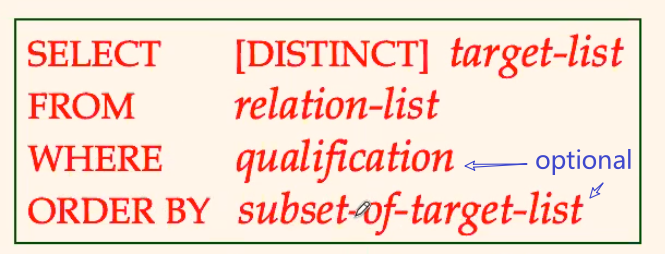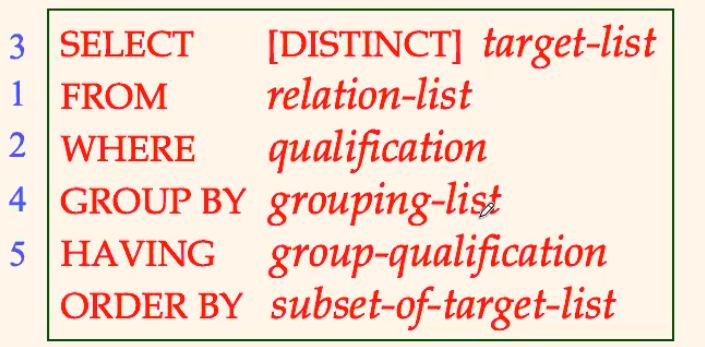COMS4111 Intro to Databases
- Week 1 - Logistics and Intro
- Week 2
- Week 3
- SQL Queries
- Advanced SQL Constraints
- Advanced SQL Queries
- Security and Authorization
- Database Application Development
- Triggers - Server Programming
- Normal Forms
- Final
- Beyond CS4111
- Useful Tricks
Week 1 - Logistics and Intro
- Course Website http://www.cs.columbia.edu/~biliris/4111/21s/index.html
- Exams are open book
Introduction
Some terms to know:
Definitions:
- Database
- a very large, integrated (relational) collection of shared data
- DBMS - database management system
- software that can manage database systems, with the advantage of reducing application development time, concurrent accesses, recovery from crashes, etc.
- Data Models
- a collection of concepts/structure for describing the data
- for example, is it a graph (social network data)? A tree? A table?
- Schema
- a description of a particular collection of data, using the data model
- It defines how the data is organized and how the relations among them are associated. It formulates all the constraints that are to be applied on the data.
- Relational Data Model
- basically a set of inter-related tables containing your data
The levels of abstraction used in this course:
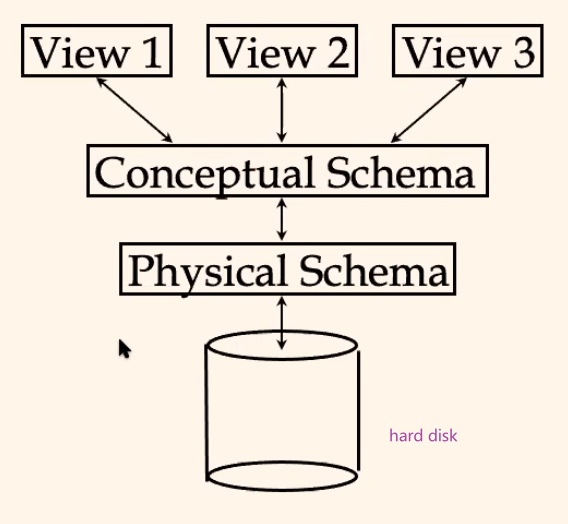
where:
- Physical Database Schema − This schema pertains to the actual storage of data and its form of storage like files, indices, etc. It defines how the data will be stored in a secondary storage.
- Conceptual/Logical Database Schema − This schema defines all the logical constraints that need to be applied on the data stored. It defines tables, views, and integrity constraints.
For example:
Consider a simple university database:

where:
- the Enrolled table connects the Students and Courses table
- so the conceptual schema tells you the organization of the table

and:

where:
- this would be a computed table based on the actual tables we have (defined in the conceptual schema)
Definition: Data Independence
- From the above, it can be implied that we need our application to be insulated from how the data is structured, so that the structure/organization should be intact
- logical data independence - protection from changes in logical structure of data
- physical data independence - protection from changes in physical structure of data
Definition: Transactions in Database
- Transactions (a query/insert/… in database) is either committed or aborted (all-or-none)
- This means it is important for having a concurrency control
- Lock based protocol
- Time-stamp protocol
- Validation based protocol
This means that we will have the following structure for a DBMS:
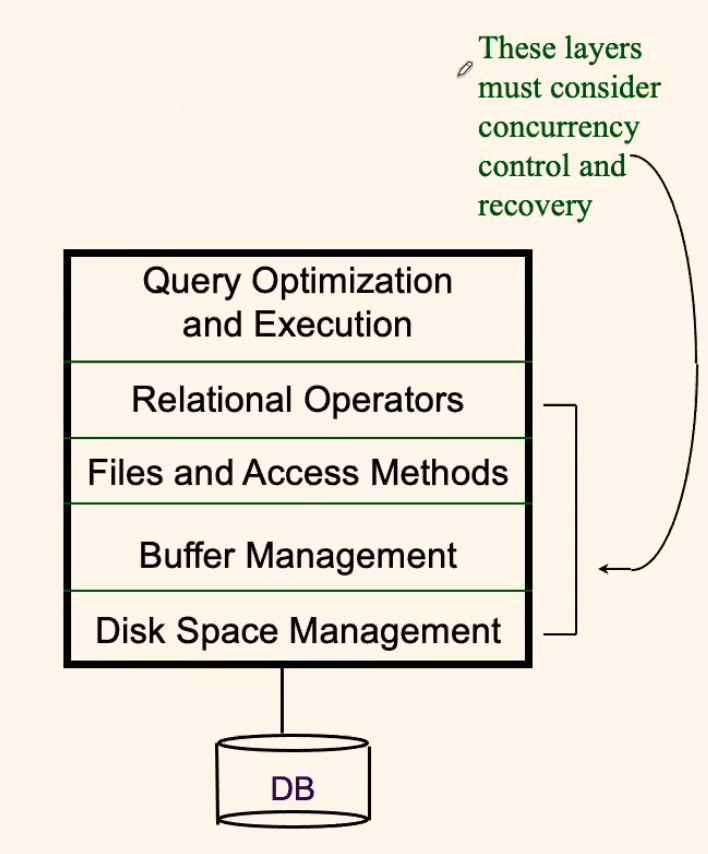
Overview of Database Design
Conceptual Design (using ER Model)
- What are the entities and relationships in the enterprise?
- What are the integrity constraints or business rules that hold?
- Can map an ER diagram into a relational schema?
Physical Database Design and Tuning
- Considering typical workloads and further refine the database design
ER Diagram Basics
What is an ER Model? Why do we need it?
- in short, it provides an abstract way of understanding the model without touching the data
Definition
- Entity
- real-world object, described using a set of attributes
- Entity Set
- a collection of entities that have the same attribute fields
- each entity set has a key (could be a composite key as well)
For example:

where:
- employee would be an entity
-
employees would be a table containing the entity employee
- the primary key would be the ssn
Definition
- Relationship
- Association among two or more entities.
- Relationship Set
- A collection of similar relationships
For example:

where:
- Entity would be in square
- Relationship would be in a diamond
- Attributes would be in circle
Key and Participation Constraints
Before going to the details, first we talk about some notations:
The following relations are possible between one entity E another entity E’:
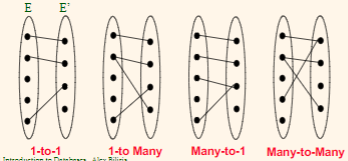
and in a more abstracted way:
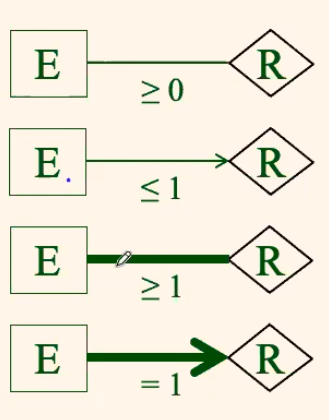
where:
- an arrow with head means upper-bounded with the 1-1 relationship
- a bold line means a strong requirement that each entity must have a relation
For Example:
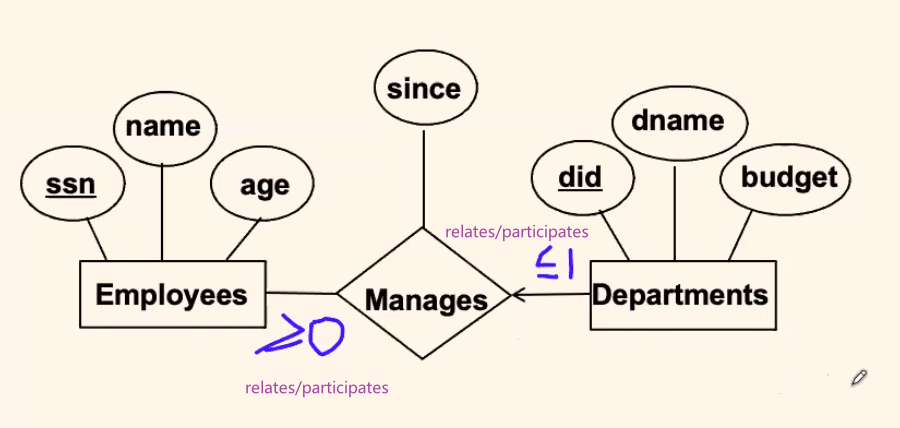
Now, we can go to key and participation constraints:
Key Constraint
the above diagram actually is a key constraint:
where:
- since each department can participate at most one time in the relationship, each department has most one manager (or zero manager) = key constraint
- each employee can manage zero or more departments
Participation Constraint:
where we see it means:
- Each department must have a manager, because it participates exactly one = participation constraint
- The participation constraint of Departments in Manages is said to be total (vs. partial).
For example:
Consider a more complicated case:
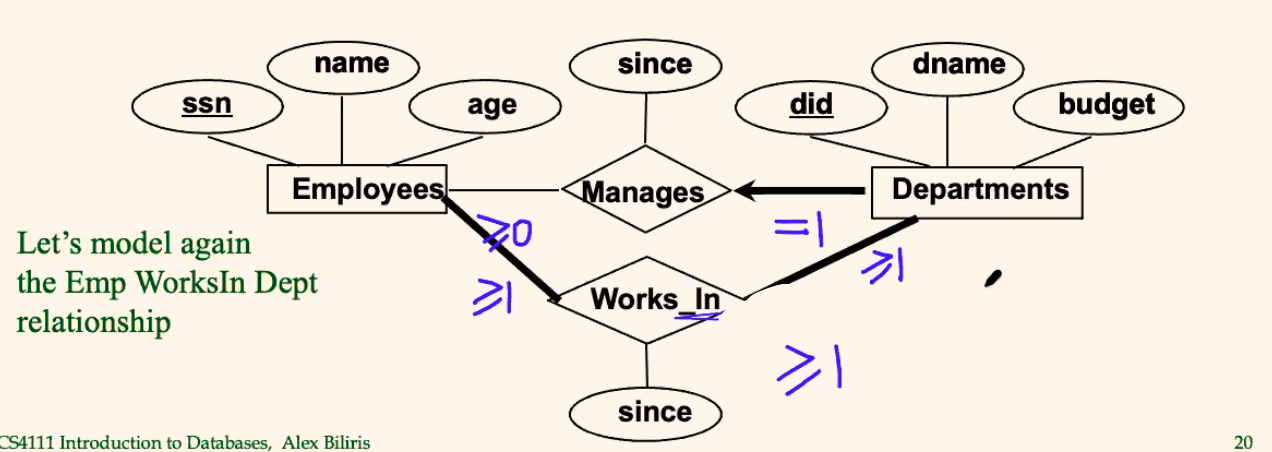
where, for the works_in relationship:
- each Department participates at least once, meaning each department has at least one employee
- each Employee works in at least one Department
Some summaries:
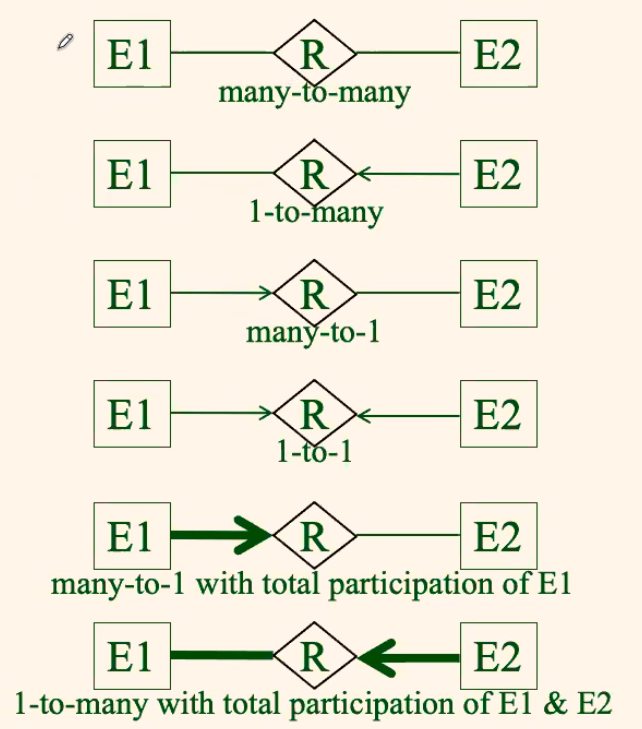
Weak Entities
Definition
- A weak entity can be identified uniquely only by considering the primary key of another (owner) entity.
- so that the weak entity does not “exist” automatically if the owner is deleted
- Owner entity set and weak entity set must participate in a one-to-one or one-to–many relationship set (one owner, one or many weak entities; each weak entity has a single owner).
- Weak entity set must have total participation in this identifying relationship set.
For example:

where:
- the entity Dependent (weak entity) depends completely on the existence of an Employee
- once a Policy/Employee is deleted, the Dependents of that policy/employee will automatically be disregarded
“Is A” Hierarchy
This is basically the same concept in OOP programming, in the context that:
- children inherits the attributes of the parent
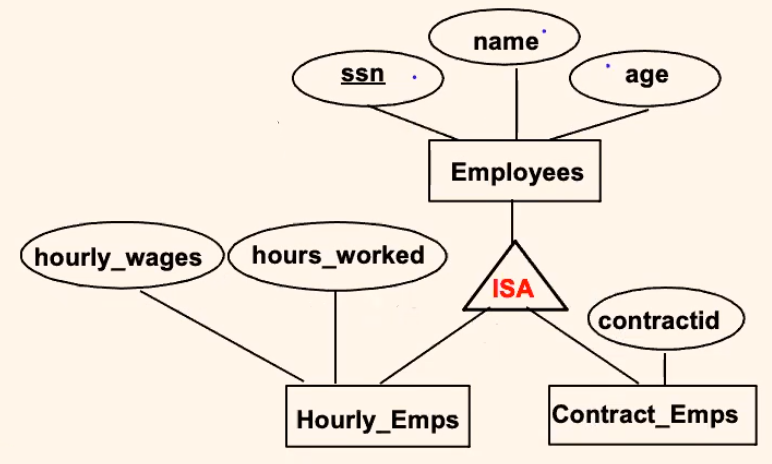
However, if using this design, you need to consider the following:
Overlap constraints:
- Can Joe be an
Hourly_Empsas well as aContract_Empsentity? (Allowed/disallowed)
Covering constraints:
- Does every
Employeesentity also have to be anHourly_Empsor aContract_Empsentity?(Yes/no)
Reasons for using ISA:
- To add descriptive attributes specific to a subclass easily.
- e.g. easily look up an
Hourly_Empinformation (name) in theEmployeetable
- e.g. easily look up an
- To identify entities that participate in a relationship.
Week 2
ER Diagram Continued
Aggregation
General Constraint:
- Usually, you should not relate relationships, you should only relate entities.
But what if you kind of need to?
For Example:
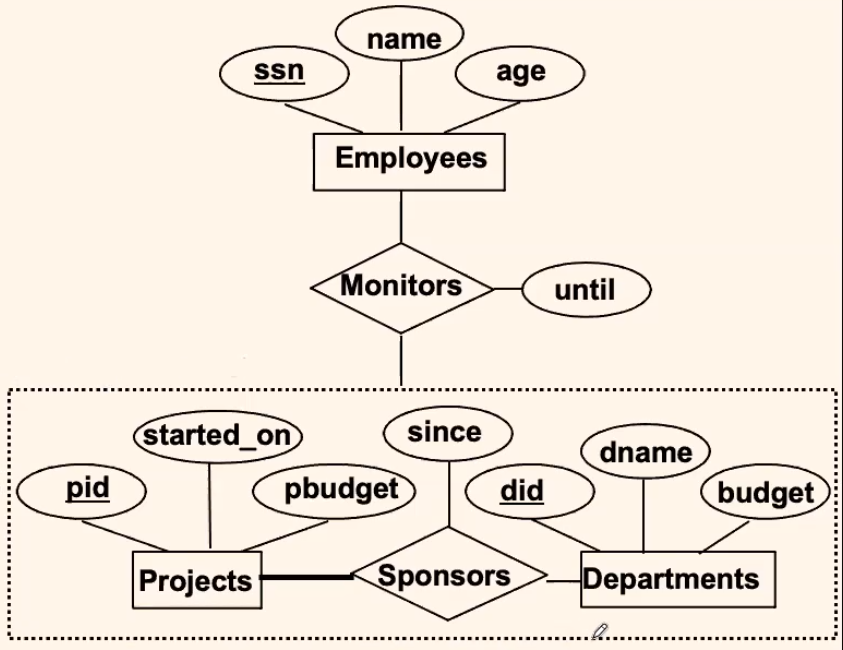
where:
- we want the
Employeeto monitor not only the project, but also how the budget flow in this sponsorship. This means theEmployeemonitorspbudget+since+budget- Practically, you could just have an aggregate entity consists of
pid,did,since
- Practically, you could just have an aggregate entity consists of
- so what we do is to view/aggregate the entire
Project+Sponsors+Departmentas one entity
Definition: Aggregation
- Allows us to treat a relationship set as an entity set for purposes of participation in (other) relationships.
Conceptual Design Using ER Model
Design choices:
- Should a concept be modeled as an entity or an attribute or a relationship?
- Identifying relationships: Binary or ternary? Aggregation?
Constraints in the ER Model:
- A lot of data semantics can (and should) be captured.
- But some constraints cannot be captured in ER diagrams.
Entity vs. Attribute
For Example: Design Choice
Should address be an attribute of Employees or an entity (connected to Employees by a relationship)?
Ans: depends upon the use we want to make of address information, and the semantics of the data:
- If we have several addresses per employee,
addressmust be an entity - If the structure/components of it (city, street, etc.) is important, e.g., we want to retrieve employees in a given city, address must be modeled as an entity (since attribute values are atomic).
- If all you need it to lookup/retrieve its entirety, then an attribute would suffice
Entity vs. Relationship
For Example
Consider the case: A manager gets a separate discretionary budget for each dept
- First ER Diagram
- works

Note
- the relational attribute
dbudget(discretionary budget) depends on both theEmployeeand theDepartment. Hence, it is not an attribute ofDepartment(e.g. a department might not have a manager, then there will be nobudget)
Consider the case: A manager gets a discretionary budget that covers all his/her managed depts
- then, the above diagram is bad, because:
- Redundancy:
dbudgetstored for each dept managed by manager. - Misleading: Suggests
dbudgetassociated with department-mgr combination.
- Redundancy:
- In short, the
dbugetdepends on only theEmployeewho manages at least one departments
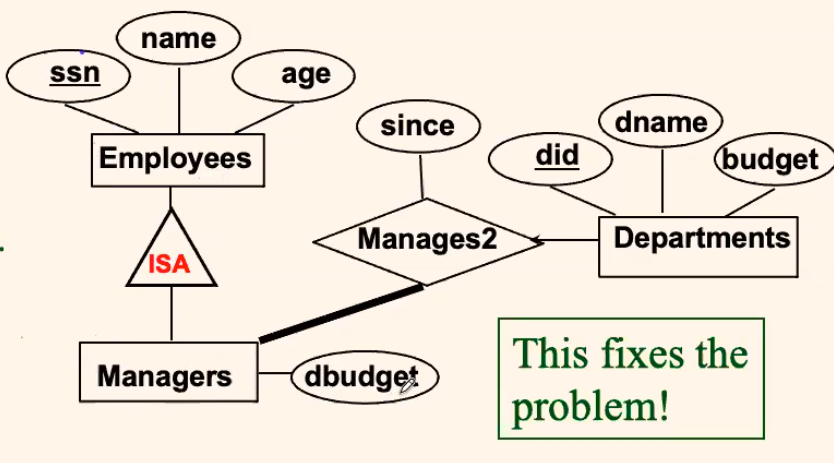
where:
- the constraint above is: each
Managermanages at least oneDepartment. Hence, we have a thick line.
Binary vs. Ternary Relationship
In most of the time
- A relationship would be no more than ternary, unless it IS EXTREMELY complicated
For Example: Binary Relationship
Consider: If each policy is owned by just 1 employee, and each dependent is tied to the covering policy
- This diagram would be inaccurate
- we cannot constraint both:
policycan only be owned by oneemployeeandpolicycan have multipledependents, i.e. the constraint is different for the relationships
- we cannot constraint both:
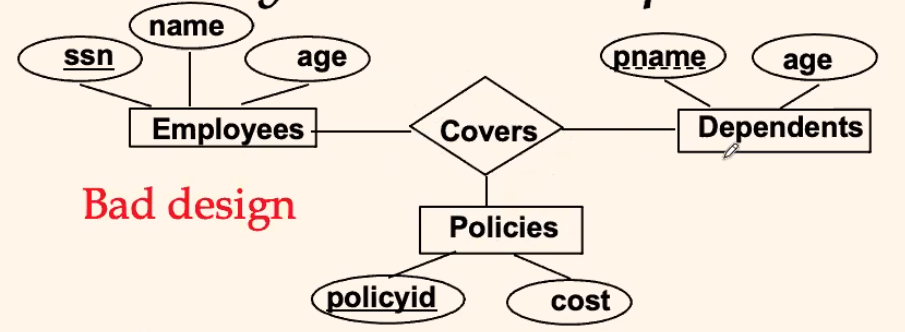
- This diagram would work:
- now, since the constraint is different, we separated them into:
- each
policyis owned by onepurchaser policycan have multipledependents
- each
- now, since the constraint is different, we separated them into:
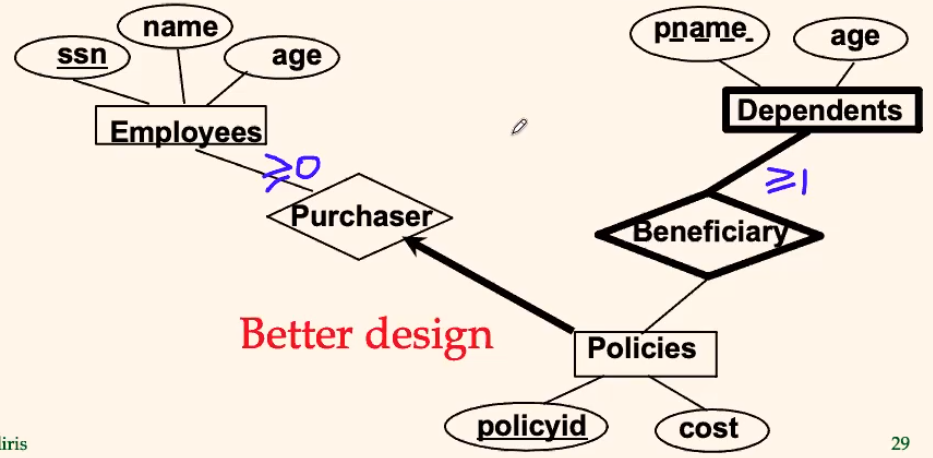
For Example: Ternary Relationship
Consider: Orders relates entity sets Suppliers, Departments and Parts
- An order
<S,D,P>indicates: a supplierSsupplies to a departmentDqtyofa partPat a certaincoston a certaindate. - All of them have no constraints
Then this would work:
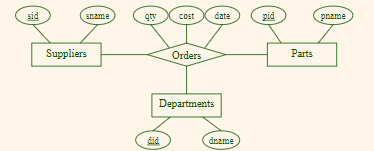
Summary:
- When the relationships involved have the same constraint, then ternary relationship would work
- Otherwise, you need to separate the relationships
For Example: Additional Constraints
Consider: Orders relates entity sets Suppliers, Departments and Parts, with these additional constraints
- A
departmentmaintains a list of approved suppliers who are the only ones that can supply parts to the department - Each
suppliermaintains a list of parts that can supply
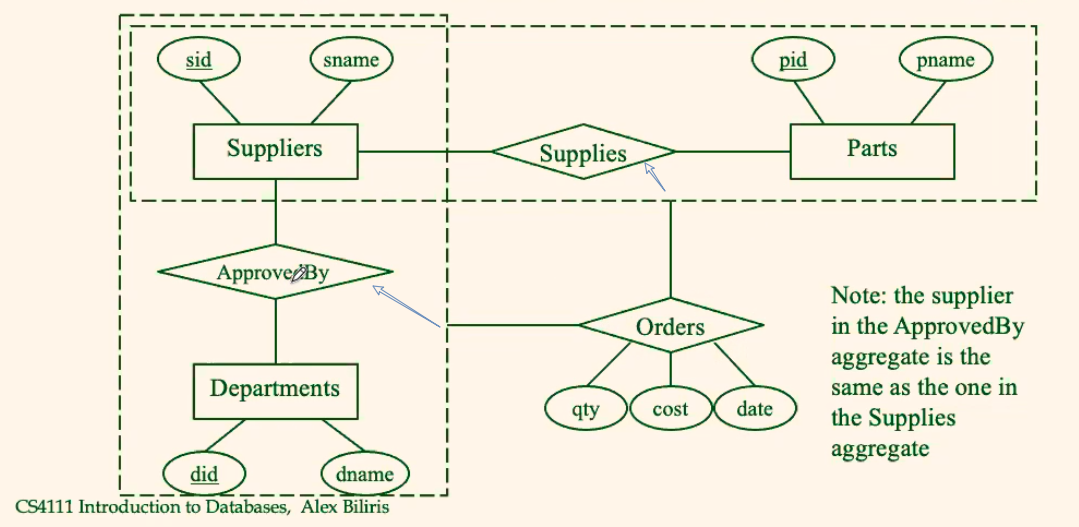
where:
- again, since you should not relate relationships, you have the aggregates
- however, a diagram cannot represent: the
supplierof thedepartmentand thesupplierof thepartsis the same in one order. Therefore, for that you can only write a note in your diagram
Or alternatively:

where:
- an
INOwould be useful for retrieving - each
Invoicehere can include more than one “orders”, so you can have multipleSD+SPassociated with oneinvoice
Summaries on ER Model
- Conceptual design follows requirements analysis
- Yields a high-level description of data to be stored
- ER model popular for conceptual design
- Constructs are expressive, close to the way people think about their applications
- Basic constructs: entities, relationships, and attributes (of entities and relationships).
- Think about constraints
- Some additional constructs: weak entities, ISA hierarchies, and aggregation.
Note:
- There are many possible variations on ER model.
Relational Model and Database
By far, the relational model/database is the most widely used.
Major vendors:
- Oracle, 44% market share (source: Gartner)
- IBM (DB2 and Informix), 22%
- Microsoft (SQL Server), 18%
- SAP (bought Sybase in 2010), 4.1%
- Teradata, 3.3%
A major strength of the relational model:
- supports simple, powerful querying of data.
- Queries can be written intuitively, and the DBMS is responsible for efficient evaluation
Definitions
Relational database:
- a set of relations (tables)
A relation (table)
- is a set of tuples (rows)
- Schema: name of relation, name and type of each column, constraints.
- e.g.
Students(sidstring, namestring, loginstring, ageinteger, gpareal).- #columns= degree / arity
- Instance: the actual table (i.e., its rows) at a particular point in time.
- All rows in a table are distinct.
- columns could be the same
For Example
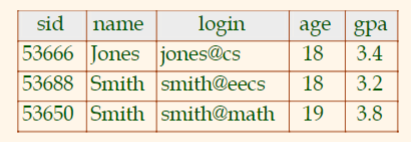
Basic SQL Query Language
For Example:

To find all 18 year old students, we write:
SELECT * FROM Students WHERE age=18
or
SELECT * FROM Students S WHERE S.age=18
Sis used when you need to avoid ambiguities when querying multiple tables
CRUD Relations/Tables in SQL
To create a table:
CREATE TABLE Students(sid CHAR(20), name CHAR(20), login CHAR(10),age INTEGER,gpa REAL)
To delete a table
DROP TABLE Students
To alter a table design:
ALTER TABLE Students ADD COLUMN firstYear: integer
Note
- The schema of
Studentsis altered if you change the structure- In the above, the structure is changed by adding a new field
- every tuple in the current instance is extended with a
nullvalue in the new field.
To update data into a table:
INSERT INTO Students (sid, name, login, age, gpa) VALUES (53688, ‘Smith’, ‘smith@ee’, 18, 3.2)
or
DELETE FROM Students S WHERE S.name = ‘Smith’
Integrity Constraints
You can specify constraints in your table, such that:
- IC condition that must be true for any instance of the database
- ICs are specified when schema is defined
- ICs are checked when relations are modified
- A legal instance of a relation is one that satisfies all specified ICs
Primary Key Constraint
Key
- A set of fields is a key for a relation if:
- No two distinct tuples can have same values in all key fields, and
- This is any subset of the key becomes non-distinct, i.e. cannot be further decomposed
- e.g.
uniwould be a key
Superkey
- superkey is basically a union/superset of keys
- e.g.
uni+lastnamewould be a superkey
Candidate and Primary Key
- Candidate key: any of the keys
- there can be multiple candidate keys in a table
- Primary key: one of the keys chosen DBA
- there can only be one Primary key in a table
Primary/Unique/Not null
Syntaxes:
PRIMARY KEY (att1, att2, ...)
UNIQUE (att1, att2, ...)
att NOT NULL
For example: Primary Key
CREATE TABLE Enrolled (
sid CHAR(20)
cid CHAR(20),
grade CHAR(2),
PRIMARY KEY (sid,cid)
)
means
- For a given student and course, there is a single grade, or:
- A student can only get one grade in an enrolled course
For example: Unique
CREATE TABLE Enrolled (
sid CHAR(20),
cid CHAR(20),
grade CHAR(2),
PRIMARY KEY (sid),
UNIQUE(cid, grade)
)
means
- A student can only take one course, and
- No two students can have the same grade in a course
For Example: Not Null
CREATE TABLE Students (
age INTEGER NOT NULL
)
Foreign Keys
Foreign keys keep referential integrity
Foreign Key
- Fields in one tuple that is used to refer to another tuple’s
PRIMARY KEYorUNIQUE.
- Like a logical pointer, and it must exists. Otherwise, some optional actions will be taken (see below)
- Referential integrity is achieved if all foreign key constraints are enforced, i.e., no dangling references.
For example
Consider the following referential integrity needed

CREATE TABLE Enrolled(
sid CHAR(20),
cid CHAR(20),
grade CHAR(2),
PRIMARY KEY (sid,cid),
FOREIGN KEY (sid) REFERENCES Students
)
where:
- the last line written in full is
FOREIGN KEY (sid) REFERENCES Students (sid)
Now, to enforce referential integrity, consider:
- What should be done if an
Enrolledtuple with a non-existent student id is inserted? - What should be done if a
Studentstuple is deleted?
SQL/99 supports all 4 options on deletes and updates.
- Default is NO ACTION (delete/update is rejected)
- e.g. you cannot delete
53666ofEnrolledorStudent
- e.g. you cannot delete
- CASCADE (also delete all tuples that refer to deleted tuple)
- e.g. deleting
53666inEnrolledwill also delete53666inStudent
- e.g. deleting
- SET NULL /SET DEFAULT (sets foreign key value of referencing tuple)
CREATE TABLEEnrolled(
sid CHAR(20),
cid CHAR(20),
grade CHAR(2),
PRIMARY KEY (sid,cid),
FOREIGN KEY (sid)
REFERENCES Students
ON DELETE CASCADE
ON UPDATE SET DEFAULT
)
Views
View
- A view is basically a ‘fictitious table’, such that
- all of its data are computed at real time from another table at the time it is accessed
- hence, it only stores definitions
Syntaxes
- Creating a
view
CREATE VIEW YoungGoodStudents (sid, name, gpa) AS(
SELECT S.sid, S.name, S.gpa
FROM Students S
WHERE S.age < 20 and S.gpa >= 3.0
)
- Deleting a
view
DROP VIEW YoungGoodStudents
Since view dependent on actual tables:
- How to handle
DROP TABLEif there’s a view on the table?DROP TABLEcommand has options to let the user specify this.
Week 3
ER to Relational Database
How to we map what we have done in ER Diagram into Database?
Entity Sets to Tables
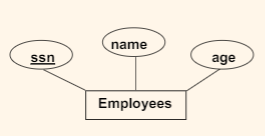
with:
CREATE TABLE Employees (
ssn CHAR(11),
name CHAR(20),
age INTEGER,
PRIMARY KEY (ssn)
)
Relationship Sets to Tables
Now, relationships are basically tables with mostly foreign keys.
- but now, we need to think about how to map the 1-to-many/many-to-1.,,, relationship
Many-to-Many Relationship:

with:
CREATE TABLE Works_In(
ssn CHAR(11),
did INTEGER,
since DATE,
PRIMARY KEY (ssn, did),
FOREIGN KEY (ssn) REFERENCES Employees,
FOREIGN KEY (did) REFERENCES Departments
)
where:
PRIMARY KEY (ssn, did)essentially implements the many-to-many constraint
Key Constraint/ At Most 1 Participation
So that Departments can participate at most once

with:
-
three-table solution
CREATE TABLE Manages ( did INTEGER, ssn CHAR(11) NOT NULL, // ok if NULL? No. Then the Manages table does not make sense since DATE, PRIMARY KEY (did), FOREIGN KEY (ssn) REFERENCES Employees, FOREIGN KEY (did) REFERENCES Departments )so that if it appears on this table, there is one manager. If a department does not have a manager, it is not in this table (this is the sole purpose of a relationship table)
-
two-table solution
CREATE TABLE Dept_Mngr( did INTEGER, dnameCHAR(20), budget REAL, ssn CHAR(11), // ok if NULL. Represents a Dept without Manager since DATE, PRIMARY KEY (did), FOREIGN KEY (ssn) REFERENCES Employees )since each
Depthas a unique manager, combineManagesandDeptsinto one table.- now, a
Deptcan at most have one manager since it is anattributethat isnullable
- now, a
Total Participation Constraint (=1/One to One)
Now, using the Dept_Mngr table is simply:
-
CREATE TABLE Dept_Mngr( did INTEGER, dname CHAR(20), budget REAL, ssn CHAR(11) NOT NULL, since DATE, PRIMARY KEY (did), FOREIGN KEY (ssn) REFERENCES Employees, ON DELETE NO ACTION )now, we have
ssnbeingNOT NULL, so that each department has exactly one manager- if it is one-to-one, then it is basically an attribute
-
This means a relationship table would not capture the constraint anymore:
CREATE TABLE Manages ( ssn CHAR(11) NOT NULL, did INTEGER, since DATE, PRIMARY KEY (did), FOREIGN KEY (ssn) REFERENCES Employees, FOREIGN KEY (did) REFERENCES Departments ) // Does not workthere is no constraint that forces ALL entries of
Deptto appear here
Total Participation Constraint ($\ge$1)
Without Check constraint, this is not possible.
-
Consider the following:
CREATE TABLE Dept_Mngr( did INTEGER, dname CHAR(20), budget REAL, ssn CHAR(11), // ssn is a PK, so no need to NOT NULL since DATE, PRIMARY KEY (did, ssn), FOREIGN KEY (ssn) REFERENCES Employees, ON DELETE NO ACTION )this would work physically, but there would be redundancy, which would be a source of error for CRUD
dname CHAR(20)andbudget REALwould be repeated
-
Similarily:
//3 tables (Emp, Dept, Manages) CREATE TABLE Manages ( ssn CHAR(11), did INTEGER, since DATE, PRIMARY KEY (did, ssn), FOREIGN KEY (ssn) REFERENCES Employees, FOREIGN KEY (did) REFERENCES Departments )which would not work since a relationship table cannot force total participation
Weak Entity to Tables
Reminder
- A weak entity should only make sense by considering the PK of the owner
- depends entirely on the existence of an owner
Consider:

with:
// Dependents and Policy are translated into ONE TABLE
CREATE TABLE Dep_Policy (
pname CHAR(20),
age INTEGER,
cost REAL,
ssn CHAR(11),
PRIMARY KEY (pname, ssn),
FOREIGN KEY (ssn) REFERENCES Employees
ON DELETE CASCADE
)
where:
- Weak entity set and identifying relationship set are translated into a single table.
- so that entries in
Dependentswill also be deleted when the owner is gone
- so that entries in
- When the owner entity is deleted, all owned weak entities must also be deleted.
Alternatively:
if you want to keep the three table structure:
CREATE TABLE Policies (
policyid INTEGER,
cost REAL,
ssn CHAR(11) NOT NULL,
PRIMARY KEY (policyid),
FOREIGN KEY (ssn) REFERENCES Employees,
ON DELETE CASCADE
)
CREATE TABLE Dependents(
pname CHAR(20),
age INTEGER,
policyid INTEGER,
PRIMARY KEY (pname, policyid),
FOREIGN KEY (policyid) REFERENCES Policies,
ON DELETE CASCADE
)
so that:
- When the owner entity is deleted, all owned weak entities together with policy are also be deleted.
Compact SQL Notation
This is only for writing to quickly clarify the design. This will not compile.
Examples include:

Note:
- Never omit the always crucial
PK,UNIQUE,NOT NULLandFKconstraints
ISA Hierarchies
Reminder
- This is basically the OOP concept of inheritance
- Additionally, some constraints here include:
- Overlap constraints: can an entry go into both children?
- Covering constraints: does an entry in parent forces an entry in at least one of the children?
In general, this is not supported naturally by relational database, but there are some approaches:
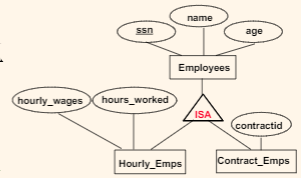
-
Emps(ssn, name, age, PK(ssn))Hourly_Emps(h_wages, h_worked, ssn, PK(ssn), FK(ssn) -> Empson delete cascade)Contract_Emps(c_id, ssn, PK(ssn), FK(ssn) -> Emps on delete cascade)so that you basically manually creates the ISA relationship
-
Hourly_Emps(ssn, name, age, h_wages, h_worked)Contract_Emps(ssn, name, age, c_id)this makes queries easier, but there may be redundancy
However, the above design all depends on:
- Overlap constraint: being both
Hourly_EmpsandContract_Emps- redundancy for the second design
- if not, no redundancy
ER Design Examples
Orders example #1
Consider the following ER:
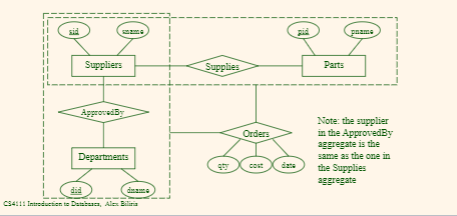
and we need that:
- the supplier in the
ApprovedByaggregate is the same as the one in theSuppliesaggregate
then the SQL tables would be:
-
Entities:
Suppliers (sid, sname)Parts (pid, pname)Departments (did, dname) -
Relationships:
ApprovedBy(sid, did, FK(sid) -> Suppliers, FK(did) -> Departments)Supplies (sid, pid, FK(sid) -> Suppliers, FK(pid) -> Parts) -
Aggregate
``Orders (sid, did, pid, qty, cost, date,`
PK(sid, did, pid, qty, cost, date)FK(sid, did) -> ApprovedBy,FK(sid, pid) -> Supplies)where:
- there is only one
sid Ordersrelates to bothApprovedByaggregate andSuppliesaggregate by the twoFK
- there is only one
Orders example #2
Consider this example:
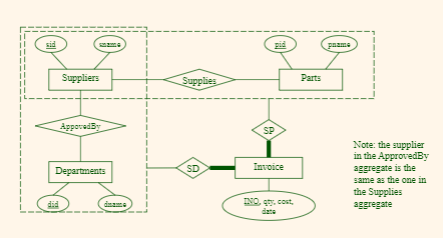
where:
-
Entities: same as above
-
Relationship: same as above
-
Aggregate:
Invoice(INO,sid NOT NULL, did NOT NULL, pid NOT NULL, qty, cost, date,PK(INO),FK(sid, did) -> ApprovedBy,FK(sid, pid) -> Supplies)where:
- the idea is basically the same as before, the only advantage is that it only requires
PK(INO)to get an entry, as compared to the previousPK(sid, did, pid, qty, cost, date)
- the idea is basically the same as before, the only advantage is that it only requires
Relational Query Languages
Query Languages
- Query languages: Allow manipulation and retrieval of data from a database.
Query
- Queries are applied to tables, and they output tables
- i.e. the schema of the input and the output of a query is always the same, but the data inside might be different depending on data changes in the actual schema
Relational Algebra
In short, all tables are essentially sets, since each entry/row is unique.
Therefore, we have the following operations in SQL:
Basic operations:
- Selection ($\sigma$): Selects a subset of rows from relation.
- Projection ($\pi$): Deletes unwanted columns from relation.
- Cross-product ($\times$): Allows us to combine two relations.
- Set-difference ($\setminus$ or $-$): Tuples in reln. 1, but not in reln. 2.
- Union ($\cup$): Tuples in reln. 1 and in reln. 2.
Additional operations:
- Intersection $\cap$, join, division, renaming: Not essential, but (very!) useful.
Since each operation returns a relation, operations can be composed! (Algebra is “closed”.)
Operators Definitions
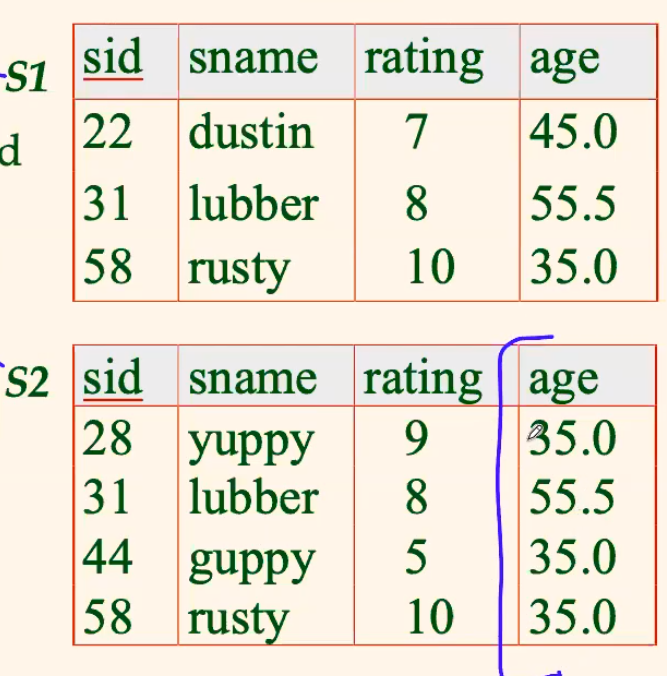
Projection
-
\[\pi_{sname, rating} (S2)\]
gives:
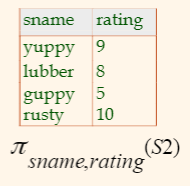
-
\[\pi_{age}(S2)\]
gives:
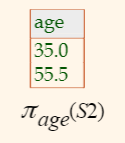
Selection
-
\[\sigma_{rating>8}(S2)\]
gives:
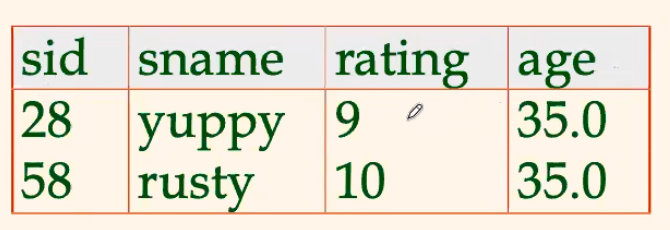
-
\[\pi_{sname, rating}(\sigma_{rating>8}(S2))\]
gives:
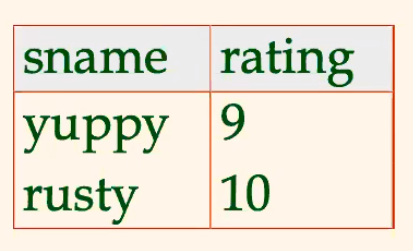
Set Operations are trivial
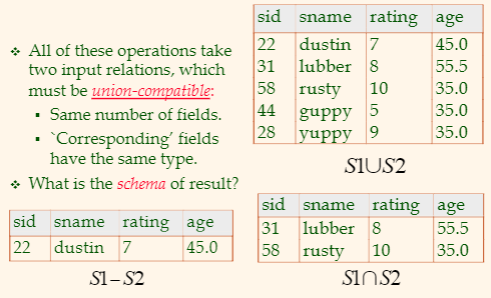
but note:
- the only thing you need to make sure is that all entries are unique
- tables need to be union-compatible
- contains the same number of attributes
- attributes are of the compatible type
- so that each row can be compared
Cartesian Product
Consider:
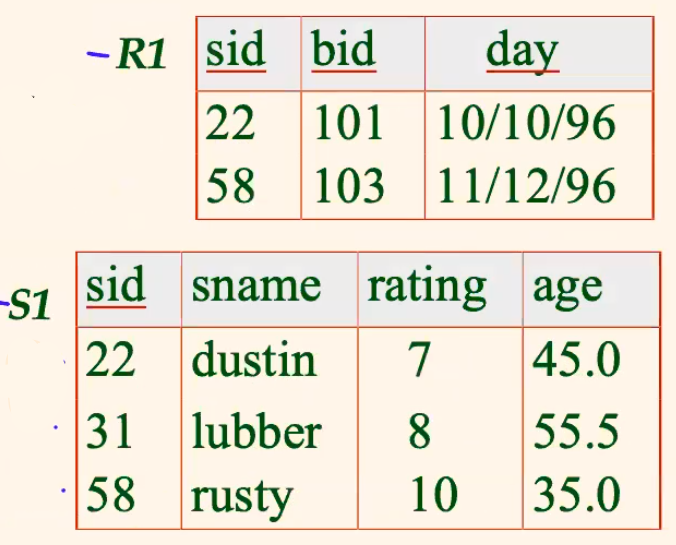
-
\[S1 \times R1\]
gives:
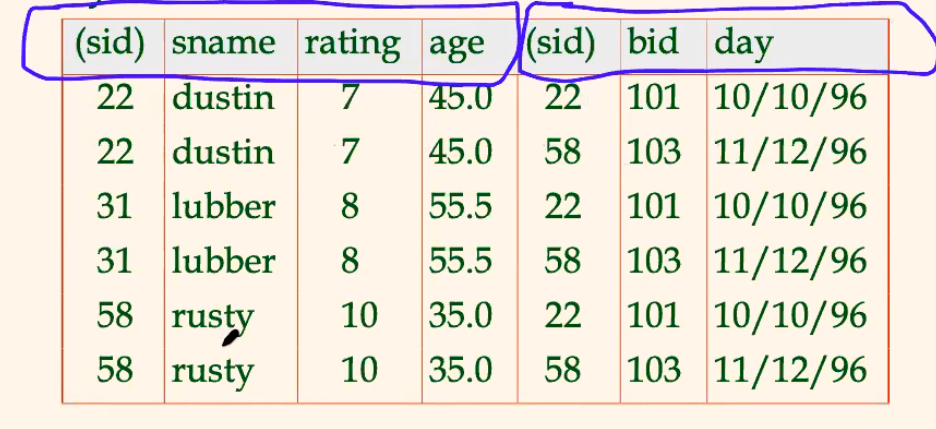
where:
-
Conflict: Both
S1andR1have a field calledsid. (but the cartesian product does not care)-
usually here you would rename: $$
\rho(C(1\to sid1, 5\to sid2),S1\times R1)
$$
-
-
the cartesian product itself is usually useless. You will need to do some additionally operations.
-
Joins
-
Condition join is a combination of cartesian product and selection $$
\sigma_{condition}(R \times S) \equiv R \bowtie_{condition} S
$$
-
for example: $$
S1 \bowtie_{S1.sid < R1.sid}R1
$$ gives:

Note
- This might be able to compute more efficiently
-
Equi-Join is a selection based on some equality
-
for example: $$
S1 \bowtie_{sid}R1
$$ gives:

-
Natural Join Equijoin on all common fields (fields with the same name and the same type)
-
for example: $$
S1 \bowtie R1
$$ gives the same:

since
sidis the only common field for tableS1and tableR1
Division
-
Let
Ahave 2 fields,xandy;Bhave only fieldy: $$A/B = { \lang x\rang\, \, \exist\lang x,y\rang \in A,\,\forall \lang y\rang \in B} $$
-
i.e.,
A/Bcontains allxtuples (sailors) such that for everyytuple (boat) in B, there is anxytuple in A. -
i.e. returns
xinAif and only if it has/tuples with allyinB -
Not supported as a primitive operator. To express this as standard operation we had before:
Idea: For A/B,
xvalue is disqualified if by attachingyvalue from B, we obtain anxytuple that is not in A. $$\pi_x(A) - \pi_x(\,(\pi_x(A)\times B)-A \,)
$$ where:
- $\pi_x(\,(\pi_x(A)\times B)-A \,)$ signifies the disqualified
xvalues (xytuple that is not in A.)
- $\pi_x(\,(\pi_x(A)\times B)-A \,)$ signifies the disqualified
-
for example:
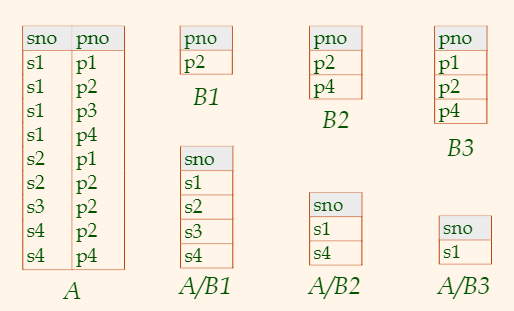
Example
For Example: Find names of sailors who’ve reserved boat #103
- so we have a
Sailorsand aReservestable
Solution:
-
The straight-forward approach $$
\pi_{sname}((\sigma_{bid=103}Reserves)\bowtie Sailors)
$$
-
Splitting the above into individual steps: $$
\begin{align} &\rho(Temp1,\,\sigma_{bid=103}Reserves))
&\rho(Temp2,\,Temp1 \bowtie Sailors)
&\pi_{sname}(Temp2) \end{align}$$
-
The “formula” approach (since many times, you simply joins first): $$
\pi_{sanme}(\sigma_{bid=103}(Reserves \bowtie Sailors))
$$
Choosing Which Query to Use
- The expression itself must be correct
- in the above case, all of them
- The expression must be easy to read/understand for yourself
- so that it there is an error, you can see it immediately
- Do not care about performance yet
- DBMS has internal query optimization made for you
For Example: Find names of sailors who’ve reserved a red boat.
- So we have three tables,
Sailors,Reserves, andBoat
Solution:
-
The straight-forward approach: $$
\pi_{sname}( (\sigma_{color=red}Boats)\bowtie Reserves \bowtie Sailors )
$$
-
The “formula” approach $$
\pi_{sname}(\sigma_{color=red}(Sailors \bowtie_{sid}Reserves \bowtie_{bid} Boats))
$$
-
etc.
For Example: Find names of sailors who’ve reserved a red or a green boat.
Solution:
-
The straight-forward approach: $$
\pi_{sname}( (\sigma_{color=red\,\lor\,color=green}Boats)\bowtie Reserves \bowtie Sailors )
$$
-
The “formula” approach $$
\pi_{sname}(\sigma_{color=red\,\lor\,color=green}(Sailors \bowtie_{sid}Reserves \bowtie_{bid} Boats))
$$
-
Computing the red and green boat separately, and then union the names
For Example: Find names of sailors who’ve reserved a red and a green boat.
Solution:
-
if this question is changed to and instead of or, then:
- changing $\lor$ to $\land$ for solution 1 and 2 would not work, because
coloris a singular value
- changing $\lor$ to $\land$ for solution 1 and 2 would not work, because
-
changing the union to intersect would not work either, because:
- if there is
sname=Mike, uid=1who borrowedredboat, and asname=Mike, uid=2who borrowedgreenboat, then the intersection will also giveMikeas the result, which is wrong - therefore, you should use primary keys before the last step
where:
- $\pi_{sname,sid} (\sigma_{red} (S \bowtie R \bowtie B))$ selects correctly unique sailors who have reserved red boat
- $\pi_{sname,sid} (\sigma_{green} (S \bowtie R \bowtie B))$ selects correctly unique sailors who have reserved green boat
- if there is
For Example: Find the names of sailors who’ve reserved all boats
Solution:
-
Using division: $$
\begin{align} &\rho(Tempsids, (\pi_{sid, bid} Reserves)/(\pi_{bid} Boats)) \end{align}
\[which gets all `sid` who has *reserved all boats*, since: - $(\pi_{sid, bid} Reserves)/(\pi_{bid} Boats)$ returns a tuple $\lang sid, bid\rang$ $\iff$ a $\lang sid \rang$ in $Reserves$ contains *columns* $\lang sid, bid\rang$ for all $\lang bid \rang$ in $Boats$ lastly, we do:\]\pi_{sanme}(Tempsids \bowtie Sailors)
$$ to fetch the names.
SQL Queries
Basic SQL Structures
Basic Select Queries
It has the following structure
where:
- by default, SQL will not remove duplicates from the query result. Therefore, sometimes you need to specify
[DISTINCT]flag.
Basic Select Query Mechanism
Fromrelation-list could be a list of relation/table names- in that case, it computes the cartesian product of the given tables
WHEREqualification are comparisons using operators such as $>,<.=,etc$, connected withAND/OR/NOT- in this case, it performs selection
SELECTtarget-list is a list of attributes of relations you wanted to have from the relation-list- performs the projection
[DISTINCT]removes duplicate rowsORDER BYjust alters the sequence of the result presented
For Example:
Find the name of sailor who has rent the boat 103.
SELECT S.sname
FROM Sailors S, Reserves R
WHERE S.sid=R.sid AND R.bid=103
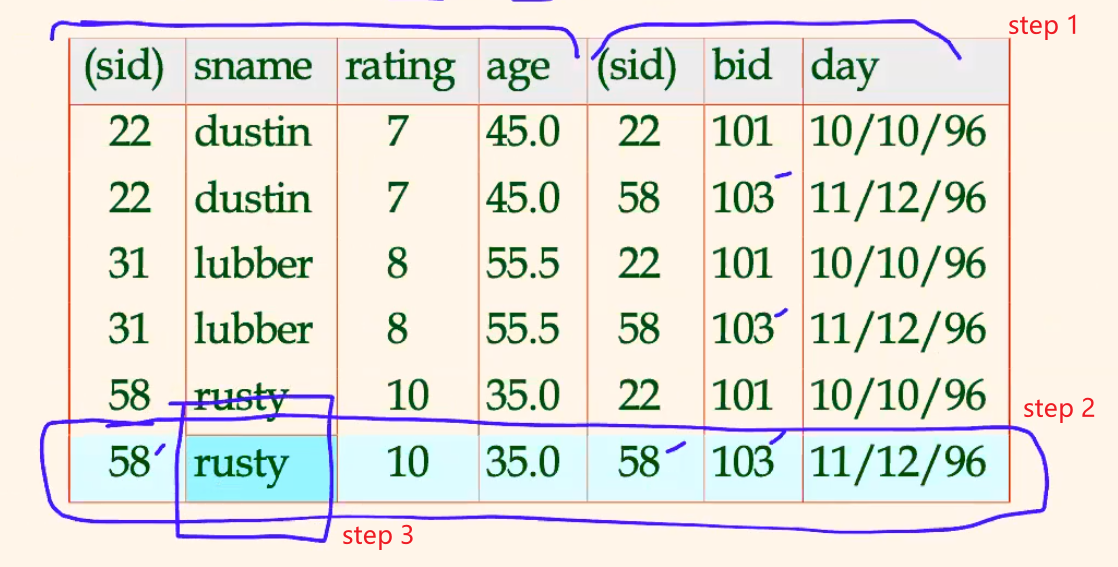
For Example:
Consider the following query:
SELECT S.sid
FROM Sailors S, Reserves R
WHERE S.sid=R.sid
will the result contain duplicate sid?
- Answer: yes, because a sailor could have reserved multiple boats, and by default
SELECTstatements do not remove duplicate results
Join Syntax
Inner Join
The below are all equivalent
SELECT S.sname
FROM Sailors S, Reserves R
WHERE S.sid=R.sid AND R.bid=103
SELECT S.sname
FROM Sailors S JOIN Reserves R ON S.sid=R.sid
WHERE R.bid=103
SELECT S.sname
FROM Sailors S INNER JOIN Reserves R ON S.sid=R.sid
WHERE R.bid=103
Expression and Strings
For Example:
SELECT age1=S.age-5,
2*S.age AS age2,
S.sid || ‘@columbia.edu’ AS email
FROM Sailors S
WHERE S.sname LIKE ‘B_%B’
where:
age1=S.age-5computesS.age-5and renames the column toage12*S.age AS age2computes2*S.ageand renames the column toage2-
S.sid||‘@columbia.edu’ AS emailconcatenatesS.sidwith@columbia.eduand renames the column toemail LIKEis used for string matching._stands for any one character and%stands for 0 or more arbitrary characters.
CASTis used for type castingCAST (S.rating as float)
Set Operations
Basic Syntax of Set Operations
query1 UNION [ALL] query2 query1 INTERSECT [ALL] query2 query1 EXCEPT [ALL] query2where:
- by default, duplicates are eliminated unless
ALLis specified!
- in this the only operation in SQL that automatically eliminates duplicates
- of course, set operations work only when they are union compatible (same columns and types)
For Example
Find sids of sailors who’ve reserved a red or a green boat.
SELECT R.sid
FROM Boats B, Reserves R
WHERE R.bid=B.bid AND B.color=‘red’
UNION
SELECT R.sid
FROM Boats B, Reserves R
WHERE R.bid=B.bid AND B.color=‘green’
alternatively, only using WHERE:
SELECT R.sid
FROM Boats B, Reserves R
WHERE R.bid=B.bid AND (B.color=‘red’ OR B.color=‘green’)
For Example
Find sids of sailors who’ve reserved a red boat but not a green boat.
SELECT R.sid
FROM Boats B, Reserves R
WHERE R.bid=B.bid AND B.color=‘red’
EXCEPT
SELECT R.sid
FROM Boats B, Reserves R
WHERE R.bid=B.bid AND B.color=‘green’
alternatively, only using WHERE
SELECT R1.sid
FROM Boats B1, Reserves R1,Boats B2, Reserves R2
WHERE R1.sid=R2.sid AND R1.bid=B1.bid AND R2.bid=B2.bid
AND (B1.color=‘red’ AND NOT B2.color=‘green’)
note that we needed two pairs to tables, Boats B1, Reserves R1,Boats B2, Reserves R2, since for a table there is only one value for color
- i.e. each record can only capture one
color. Therefore, we need two tables and combine the result usingsidandbid. (R1.sid=R2.sid AND R1.bid=B1.bid AND R2.bid=B2.bid)
Nested Queries
Nested Queries can happen in basically any where, including:
SELECTFROMWHERE- etc.
Note
In general, since we have a nested query, the scope of variables look like.
SOME QUERY with Var(S, T)For example:
SELECT S.sname /* only S is visiable */ FROM Sailors S WHERE S.sid IN (SELECT R.sid /* S and R is visible */ FROM Reserves R WHERE R.bid IN (SELECT B.bid /* S, R, B are all visible */ FROM Boats B WHERE B.color=red)where:
again, we are doing:
WHERE S.sid IN (SOME OTHER QUERY RESULT)and that the return type of
SOME OTHER QUERY RESULThas to match the type/format ofS.sid
Nested Queries and IN
IN
- essentially,
xxx IN (some query)means only keeping values ofxxxif it is the set ofsome query
- and since this is basically a set operation, the types of
xxxandsome queryhas to be union compatible- the negation will be
NOT IN
Consider the problem:
- Find names of sailors who’ve reserved boat
#103:
SELECT S.sname
FROM Sailors S
WHERE S.sid IN (
SELECT s.sid
FROM Reserves R
WHERE R.bid = 103
)
Rewriting INTERSECT with IN
Consider:
- Find id/name of sailors who’ve reserved both a red and a green boat:
SELECT S.sid, S.sname
FROM Sailors S
WHERE S.sid IN (SELECT R2.sid
FROM Boats B2, Reserves R2
WHERE R2.bid=B2.bid AND B2.color=‘red’)
AND
S.sid IN (SELECT R2.sid
FROM Boats B2, Reserves R2
WHERE R2.bid=B2.bid AND B2.color=‘green’)
where:
-
basically you are doing
S.sidis in both the sets (results of the inner queries) -
Similarly,
EXCEPT/``MINUSqueries re-written usingNOT IN`.
Nested Queries and FROM
Consider the same problem
- Find names of sailors who’ve reserved boat ``#103`:
SELECT S.sname
FROM Sailors S, (SELECT sid FROM Reserves WHERE bid=103) T
WHERE S.sid=T.sid
notice that:
-
the line:
FROM Sailors S, (SELECT sid FROM Reserves WHERE bid=103) T WHERE S.sid=T.siddid a natural join on
sidfrom the two tablesS,T
Note
if and only if the inner query
SELECT sid FROM Reserves WHERE bid=103results in only one row/result, then it would be also correct to say:SELECT S.sname FROM Sailors S, (SELECT sid FROM Reserves WHERE bid=103) T WHERE S.sid=T
Multi-level Nested Queries
Consider:
SELECT S.sname
FROM Sailors S
WHERE S.sid IN (SELECT R.sid
FROM Reserves R
WHERE R.bid IN (SELECT B.bid
FROM Boats B
WHERE B.color=red)
and it basically does “Find names of sailors who have reserved a red boat”.
Nested Queries with Correlation
Exists and Unique
EXISTSchecks for empty set
- returns true if table is not empty
UNIQUEchecks for duplicate tuples
- returns true if there are no duplicate tuples or the table is empty
Consider the problem
- Find names of sailors who’ve reserved boat
#103:
SELECT S.sname
FROM Sailors S
WHERE EXISTS (SELECT *
FROM Reserves R
WHERE R.bid=103 AND S.sid=R.sid)
where:
-
this is nested query with correlation, because the inner query
WHERE R.bid=103 AND S.sid=R.sidcorrelates/usesS.sidwhich is of the outer query -
therefore, since it used
S.sid=R.sid, this is what happened:SELECT S.sname FROM Sailors S WHERE "If each S.sid EXISTS IN (SELECT * FROM Reserves R WHERE R.bid=103 AND S.sid=R.sid)"
Similarly:
SELECT S.sname
FROM Sailors S
WHERE UNIQUE (SELECT R.bid
FROM Reserves R
WHERE R.bid=103 AND S.sid=R.sid)
Finds sailors with at most one reservation for boat ``#103. Since UNIQUE returns TRUE` if and only if the row is unique or empty.
-
and the correlation
S.sid=R.sidcan be translated to:SELECT S.sname FROM Sailors S WHERE "If each S.sid has UNIQUE data of (SELECT R.bid FROM Reserves R WHERE R.bid=103 AND S.sid=R.sid)"
Nested Queries with Set Comparison
ANY,ALLOperations
<op> ANYreturns true to the row if any of the comparison is true<op> ALLreturns true to the row if all of the comparison is true
For example:
- Find sailors whose rating is greater than that of some sailor called “Mike”
SELECT *
FROM Sailors S
WHERE S.rating > ANY (SELECT S2.rating
FROM Sailors S2
WHERE S2.sname=‘Mike’)
where:
S.rating > ANY (SELECT S2.rating ...)returnstrueto a row ofSailors SifS.ratingis larger than anyS2.ratingentry in the subquery’s table.
Division in SQL
In short, division is not supported naturally. Therefore, you need to do complicated queries.
For Example
- Find sailors who’ve reserved all boats.
SELECT S.sname
FROM Sailors S
WHERE NOT EXISTS
((SELECT B.bid
FROM Boats B)
EXCEPT
(SELECT R.bid
FROM Reserves R
WHERE R.sid=S.sid))
which basically does:
-
SELECT S.sname FROM Sailors S WHERE NOT EXISTS ( ALL_BOAT_IDs EXCEPT (Minus) ALL_BOAT_IDs_RESERVED_BY_A_SAILOR) -
then
NOT EXISTSdoes:SELECT S.sname FROM Sailors S WHERE TRUE IF_BELOW_IS_EMPTY ( ALL_BOAT_IDs EXCEPT (Minus) ALL_BOAT_IDs_RESERVED_BY_A_SAILOR)
Note
- usually, when a query involves the ALL condition, the natural thinking shout be using
DIVISION- However, since
DIVISIONis not supported naturally, when need to often compute the opposite, and minus it.
Aggregate Operators
Supported Aggregates
COUNT(*), COUNT( [DISTINCT] A)
- counts the number of rows/distinct rows of a all columns/column A
SUM( [DISTINCT] A)AVG( [DISTINCT] A)MAX(A), MIN(A)
Reminder:
- the
SELECTpart of a query is executed the last.
For Example
-
Number of sailors
SELECT COUNT (*) FROM Sailors -
Average age of all sailors whose rating is 10:
SELECT AVG (age) FROM Sailors WHERE rating=10 -
Name of sailors with maximum/highest rating
SELECT S.sname FROM Sailors S WHERE S.rating = (SELECT MAX(S2.rating) FROM Sailors S2)
Advanced SQL Constraints
Some basic SQL constraints have been covered in Integrity Constraints.
CHECK Constraints
Check Constraint
- Attribute-based
CHECKconstraints involve a single attribute
- it is basically a boolean expression, and it must evaluate to true for all rows of an attribute that has this constraint.
- If the constraint does not mention any attribute, it applies to the entire table
- e.g. if you use things like
CHECK((SELECT COUNT(*) FROM Sailors) < 100)- If any table in the
CHECKconstraint is empty (i.e. just created with no data yet), thenCHECKconstraints automatically evaluate to true
- e.g.
CHECK((SELECT COUNT(*) FROM Sailors) > 100)is true for empty table
For Example
CREATE TABLE Sailors (
sid INTEGER,
rating INTEGER,
age REAL CHECK(age >= 17), /* all rows must have age >= 17 */
PRIMARY KEY (sid),
CONSTRAINT valid_ratings
CHECK(rating >= 1 AND rating <= 10)
)
where:
-
CHECKconstraints can optionally be named. For example:CONSTRAINT valid_ratings CHECK(rating >= 1 AND rating <= 10) -
the position of
CHECKconstraints does not matter. It can be at the end as well.
For Example:
You can also check tuples:
CREATE TABLE Sailors (
sid INTEGER,
rating INTEGER CHECK (rating >= 1 AND rating <= 10),
age REAL CHECK(age >= 17), /* all rows must have age >= 17 */
PRIMARY KEY (sid),
CHECK( NOT (rating > 5 AND age < 20) ),
CHECK( NOT (rating > 7 AND age < 25) )
)
CHECK with SQL Queries
For Example
CREATE TABLE Sailors (
sid INTEGER,
rating INTEGER CHECK (rating >= 1 AND rating <= 10),
age REAL CHECK(age >= 17), /* all rows must have age >= 17 */
PRIMARY KEY (sid),
CHECK( NOT (rating > 5 AND age < 20) ),
CHECK( NOT (rating > 7 AND age < 25) ),
CHECK((SELECT COUNT(*) FROM Sailors) < 100)
)
which constraints the number of sailors to 100.
Note:
By the definition of
CHECK, the below will be true for empty tableCREATE TABLE Sailors ( sid INTEGER, rating INTEGER CHECK (rating >= 1 AND rating <= 10), age REAL CHECK(age >= 17), /* all rows must have age >= 17 */ PRIMARY KEY (sid), CHECK( NOT (rating > 5 AND age < 20) ), CHECK( NOT (rating > 7 AND age < 25) ), CHECK((SELECT COUNT(*) FROM Sailors) > 100) /* true for empty table */ )
For Example
CREATE TABLE Reserves (
sid INTEGER,
bid INTEGER,
day DATE,
PRIMARY KEY (sid, bid,day),
FOREIGN KEY (sid) REFERENCES Sailors,
FOREIGN KEY (bid) REFERENCES Boats,
CONSTRAINT noInterlakeRes /* this checks for each row of Reserves table */
CHECK( 'Interlake' <> (SELECT B.bnameFROM Boats B WHERE B.bid=bid) )
)
which basically means you cannot reserve the boat ‘Interlake’
- note that
(SELECT B.bnameFROM Boats B WHERE B.bid=bid)returns only a single row for eachbid, so you can directly compare with a string ‘Interlake’.
CHECK with Assertion
In short, when you have a CHECK constraining multiple tables, the problem comes:
- in which table should you put the constraint?
- If any table in the
CHECKconstraint is empty, thenCHECKconstraints automatically evaluate to true. This will cause buggy behavior
Assertion
- Often used for creating
CHECKconstraints for multiple tables- Does not automatically evaluate to
trueif any table is empty
- hence fixes the bug
For Example: The Wrong Approach
I want to create a small club, which that number of sailors + boat $<$ 100
-
the Wrong Approach:
CREATE TABLE Sailors ( sid INTEGER, rating INTEGER, age REAL, PRIMARY KEY (sid), CHECK ( (SELECT COUNT (*) FROM Sailors) + (SELECT COUNT (*) FROM Boats) < 100) ) )which will be buggy if one of the table
Sailors/Boatsis empty, this will be always true -
the Correct Approach:
CREATE ASSERTION smallClub CHECK ( (SELECT COUNT (*) FROM Sailors) + (SELECT COUNT (*) FROM Boats) < 100 )
Using Assertion for Total Participation
For Example

where we need:
- each sailor reserves at least one boat (total participation)
CREATE ASSERTION BusySailors (
CHECK (
NOT EXISTS (SELECT sid
FROM Sailors
WHERE sid NOT IN (SELECT sid
FROM Reserves ))
)
)
which basically means:
-
CREATE ASSERTION BusySailors ( CHECK ( NOT EXISTS (SAILOR_SID_WHO_HAS_NOT_NOT_RESERVED_A_BOAT) ) ) -
then the
NOT EXISTSmeans:CREATE ASSERTION BusySailors ( CHECK ( IS_EMPTY (SAILOR_SID_WHO_HAS_NOT_NOT_RESERVED_A_BOAT) ) )
Advanced SQL Queries
Group By
So far, we’ve applied aggregate operators to all (qualifying) tuples. Sometimes, we want to apply the aggregate operators to each of several groups of tuples.
- e.g.
AVERAGEGPA for students based on different ages (group)
For Example
- Task: Find the age of the youngest sailor for each rating level.
You would like to do this (but you cannot):

where:
- it does not work for all times because:
- often, we do not know what range of $i$ would this take
- often, the values of $i$ might not be integers/equally spaced
Therefore, we need to solve it by using GROUP BY
Queries with Group By
Now, it looks like this:
and it evaluates from:
FROM(trivial)WHERE(trivial)SELECT, basically a projection, but it must make sense for groups. Target-list/Result list here must contains/returns either:
- attribute names mentioned in
grouping-list, or- terms with aggregate operations (e.g.,
MIN (S.age)).
- aggregates are actually evaluated in the end
GROUP BYsort the result from the previous 3 steps into groups
- if you have multiple qualifications, then it sorts qualification iteratively (e.g. first sort by
qualif_1, then inside those groups, sort byqualif_2, … etc)HAVINGuses group qualification, which is basically qualification expression evaluated inside EACH GROUP
- such as the average age of sailors in each group must be > 25
- therefore, this also must use attributes in the
GROUP BYor aggregates- (optionally)
ORDER BYorders the output table from the above
For Example
Task: Find the average rating for each sailor age
Solution:
-
when you see the term for each, very probably you need to create groups
SELECT S.age, AVG(S.rating) FROM Sailors S GROUP BY S.agenote that:
- the select looks for
S.age, AVG(S.rating), which is exactly- attribute names mentioned in
grouping-list, or - terms with aggregate operations (e.g.,
MIN (S.age)`).
- attribute names mentioned in
- the select looks for
For Example
Task: Find the average rating for each sailor age greater than 25
Solution:
-
simply:
SELECT S.age, AVG(S.rating) FROM Sailors S WHERE S.age> 25 GROUP BY S.age
For Example
Task: Find the average rating for each sailor age with more than 4 sailors of that age
Solution:
-
Basically, we need each group have more than 4 members:
SELECT S.age, AVG(S.rating) FROM Sailors S GROUP BY S.age HAVING COUNT(*) > 4where notice that:
- the
HAVING COUNT(*) > 4will be discarding GROUPS fromGROUP BYthat has total member less than 4
- the
For Example
Task: Find the age of the youngest sailor with age > 18, for each rating with at least 2 such sailors (age older than 18).
Solution:
-
the trick is to filter
age>18early:SELECT S.rating, MIN(S.age) FROM Sailors S WHERE S.age > 18 GROUP BY S.rating HAVING COUNT(*) > 1
Under the hood, this is what happens:
-
the
FROMstep is skipped -
WHERE S.age > 18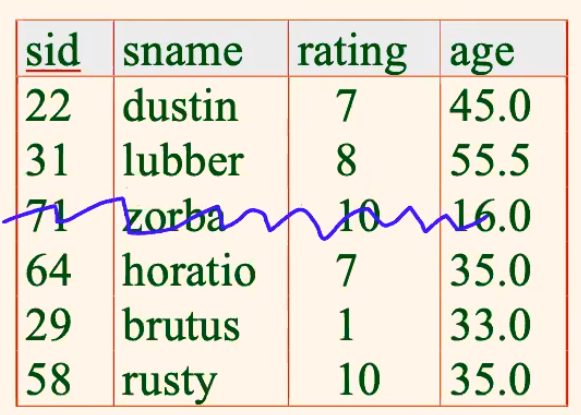
-
SELECT S.rating, MIN(S.age)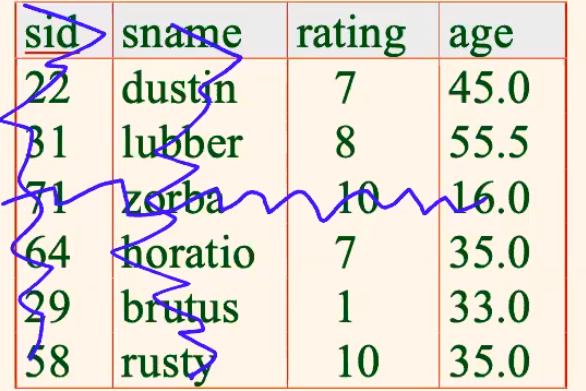
notice that the aggregate operators are not evaluated at this point
-
GROUP BY S.rating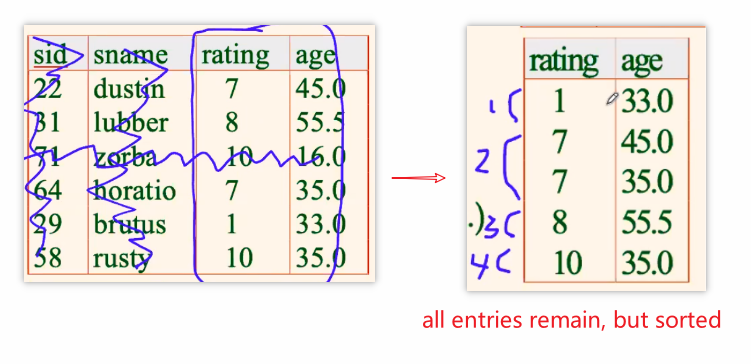
-
HAVING COUNT(*) > 1which eliminates by GROUPS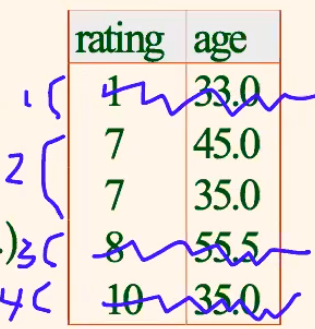
-
(Book-keeping) the aggregate operator is executed ` MIN(S.age)`:
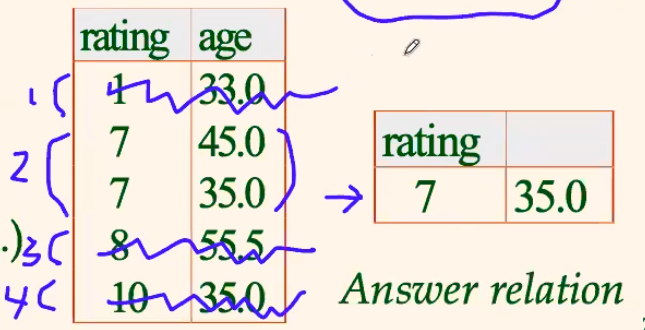
For Example:
Task: For each red boat, print the bid and the number of reservations for this boat
Solution:
SELECT B.bid, COUNT(*) AS num_of_reservations
FROM Boats B, Reserves R
WHERE R.bid=B.bid AND B.color=‘red’
GROUP BY B.bid
Alternatively:
-
SELECT B.bid, COUNT(*) AS num_of_reservations FROM Boats B, Reserves R WHERE R.bid=B.bid GROUP BY B.bid, B.color HAVING B.color='red'which does:
GROUP BY B.bid, B.colorfirst, and then filter it usingHAVING
Group By With Correlated Queries
Reminder:
HAVINGuses group qualification, which is basically qualification expression evaluated inside EACH GROUP
- such as the average age of sailors in each group must be > 25
For Example:
Task: Find the age of the youngest sailor with age > 18, for each rating with at least 2 sailors (of any age)
Solution:
-
SELECT S.rating, MIN(S.age) FROM Sailors S WHERE S.age > 18 GROUP BY S.rating HAVING 1 < (SELECT COUNT (*) FROM Sailors S2 WHERE S.rating=S2.rating)where we have to use nested correlated SQL queries:
-
SELECT S.rating, MIN(S.age) FROM Sailors S WHERE S.age > 18 GROUP BY S.rating HAVING "FOR EACH GROUP, 1 < (SELECT COUNT (*) FROM Sailors S2 WHERE S.rating_of_each_group =S2.rating)"
-
Alternatively:
SELECT S.rating, MIN (S.age)
FROM Sailors S, (SELECT rating
FROM Sailors
GROUP BY rating
HAVING COUNT(*) >= 2) ValidRatings
WHERE S.rating=ValidRatings.rating AND S.age > 18
GROUP BY S.rating
where you are basically:
- computing ratings with at least 2 sailors first
- filtering the ages to $>$ 18
- group them by each rating, and find minimum
Null Values
Basically, since we have NULL values in SQL, we need to do logical comparisons with 3-values.
AND
| T | F | N | |
|---|---|---|---|
| T | T | F | N |
| F | F | F | F |
| N | N | F | N |
Other Joins
Outer Joins
Outer Joins
- rows included even if there is no match. This row is also indicated with
Nullfields
Left Outer Join
- rows in the left table that do not match any row in the right table appear exactly once, with column from the right table assigned
NULLvalues.
- if there is a match, then there could be multiple values since it is just a cartesian product + selection
- same as Left Join
Reminder
- In the end,
JOINs are just doing a cartesian product and a $\sigma$
SELECT S.sid, R.bid
FROM Sailors S LEFT OUTER JOIN Reserves R ON S.sid = R.sid
so that:
- every row of the left table appears in the result
- if rows from the left table did not match any in the join, then it still appears but has
null- regular join will not have this functionality
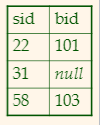
RIGHT OUTER JOIN:
- the reverse
FULL OUTER JOIN:
- both, left and right
Examples
Task: For each boat color, print the number of reservations for boats of that color (e.g., (red, 10), (blue, 3), (pink, 0))
Solution
SELECT B.color, COUNT(R.sid)
FROM Boats B LEFT OUTER JOIN Reserves R ON B.bid=R.bid
GROUP BY B.color
where:
- remember that each boat can only have one color
Task: Print the sid and name of every sailor and the number of reservations the sailor has made.
Solution:
SELECT S.sid, S.sname, COUNT(R.bid)
FROM Sailors S LEFT OUTER JOIN Reserves R ON S.sid=R.sid
GROUP BY S.sid, S.sname
Note that
- whenever you have
GROUP BY some_id, no matter how many attributes you add afterwards, it will not affect the result
Task: Print the sid of every sailor and the number of different boats the sailor has reserved.
Solution
SELECT SR.sid, COUNT(DISTINCT SR.bid)
FROM (SELECT S.sid, R.bid
FROM Sailors S LEFT OUTER JOIN Reserves R ON S.sid=R.sid) SR
GROUP BY SR.sid
Values
Basically this is used to create a constant table
For Example:
Creates a constant table
VALUES (1, 'one'), (2, 'two'), (3, 'three')
Insert into:
INSERT INTO Sailors
VALUES (22, ‘dustin’, 7, 30)
Some trick other tricks:
CREATE VIEW TopSailors AS (
SELECT sid, sname
FROM Sailors
WHERE ratings >= 10
UNION
VALUES (2264, ’Alex Biliris’)
)
Building up Complicated SQL Statements
Consider the statement:
SELECT s.sname, s.rating, COUNT(r.bid),
(SELECT AVG(s3.rating) FROM Sailors s3 WHERE s3.age=s.age) ,
(SELECT AVG(cnt)
FROM (SELECT COUNT(r4.bid) as cnt
FROM Sailors s4 LEFT OUTER JOIN Reserves r4 ON s4.sid=r4.sid
GROUP BY s4.sid, s4.age
HAVING s4.age=s.age))
FROM Sailors s LEFT OUTER JOIN Reserves r ON s.sid=r.sid
WHERE s.rating>
(SELECT AVG(s2.rating) FROM Sailors s2 WHERE s2.age=s.age)
GROUP BY s.sid, s.sname, s.rating
To parse it, we should break it into parts
Part 1:
For each sailor with rating higher than the average rating of all sailors, print the name, rating, number of boats she has reserved
SELECT s.sname, s.rating, COUNT(r.bid)
FROM Sailors s LEFT OUTER JOIN Reserves r ON s.sid=r.sid
WHERE s.rating >
(SELECT AVG(s2.rating) FROM Sailors s2)
GROUP BY s.sid, s.sname, s.rating
Part 2:
For each sailor with rating higher than the average rating of all sailors of the same age, print the name, rating, number of boats she has reserved
SELECT s.sname, s.rating, COUNT(r.bid)
FROM Sailors s LEFT OUTER JOIN Reserves r ON s.sid=r.sid
WHERE s.rating >
(SELECT AVG(s2.rating) FROM Sailors s2 WHERE s2.age=s.age) /* added here */
GROUP BY s.sid, s.sname, s.rating
notice the correlated query:
(SELECT AVG(s2.rating) FROM Sailors s2 WHERE s2.age=s.age)
Part 3
For each sailor with rating higher than the average rating of all sailors of the same age, print the name, rating, number of boats she has reserved, and the average rating of sailors of the same age
SELECT s.sname, s.rating, COUNT(r.bid),
(SELECT AVG(s3.rating) FROM Sailors s3 WHERE s3.age=s.age) /* A COMPUTED COLUMN */
FROM Sailors s LEFT OUTER JOIN Reserves r ON s.sid=r.sid
WHERE s.rating >
(SELECT AVG(s2.rating) FROM Sailors s2 WHERE s2.age=s.age)
GROUP BY s.sid, s.sname, s.rating
notice that the correlated query is now at SELECT
(SELECT AVG(s3.rating) FROM Sailors s3 WHERE s3.age=s.age)which computes the value for each matchings3.age=s.age
Part 4
For each sailor with rating higher than the average rating of all sailors of the same age, print the name, rating, number of boats she has reserved, and the average rating of sailors of the same age and average number of reserved boats by sailors of the same age
SELECT s.sname, s.rating, COUNT(r.bid),
(SELECT AVG(s3.rating) FROM Sailors s3 WHERE s3.age=s.age) ,
(SELECT AVG(cnt) /* added nested query */
FROM (SELECT COUNT(r4.bid) as cnt
FROM Sailors s4 LEFT OUTER JOIN Reserves r4 ON s4.sid=r4.sid
GROUP BY s4.sid, s4.age
HAVING s4.age=s.age))
FROM Sailors s LEFT OUTER JOIN Reserves r ON s.sid=r.sid
WHERE s.rating>
(SELECT AVG(s2.rating) FROM Sailors s2 WHERE s2.age=s.age)
GROUP BY s.sid, s.sname, s.rating
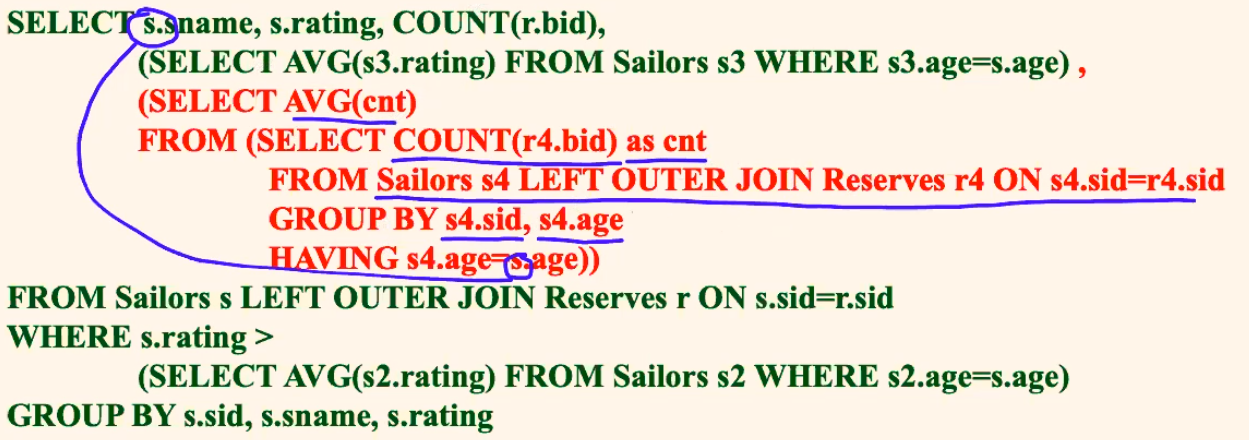
With - Auxiliary SQL
This is a trick so that you can give names to temporary tables AND use them!
Basically, you use a subquery, and name it:
WITH RedBoats AS (
SELECT *
FROM Boats WHERE color = ‘red’
), /* comma, additional WITH query */
RedBoatReservations AS (
SELECT bid, COUNT(*) AS cnt
FROM Reserves
WHERE bid IN (SELECT bid FROM RedBoats)
GROUP BY bid) /* no comma, one main SQL expected */
SELECT bid FROM RedBoatReservations
WHERE cnt> (SELECT AVG(cnt) FROM RedBoatReservations)
Note
- Not all systems support
WITH, but this is obviously very useful since it can:
- make your SQL look easier to understand
- avoid repetitive queries
Security and Authorization
Basically the goal is to make sure:
- Secrecy: Users should not be able to see things they are not supposed to.
- E.g., A student can’t see other students’grades.
- Integrity: Users should not be able to modify things they are not supposed to.
- E.g., Only instructors can assign grades.
- Availability: Users should be able to see and modify things they are allowed to.
Access Control
Access Control
- Based on the concept of access rights or privileges for objects
- e.g. privileges to
select/updatea table, etc.- this is achieved by the
GRANTcommand- Creator of a table or a view automatically gets all privileges on it.
GRANT and Revoke
Grant Command
The command looks like:
GRANT privileges ON object TO users [WITH GRANT OPTION]where:
privilegescan be the following:
SELECTINSERT/UPDATE (col-name)
- can insert/update tuples with non-null or non-default values in this column.
DELETEREFERENCES (col-name)
- can define foreign keys (to the
col-nameof other tables). This is actually powerful, in that the foreign table might not be able to delete/update is there isON DELET NO ACTION, or equivalent.- this also means that by default, you can only foreign key in our own granted access tables
ALLall privileges the issuer ofGRANThasobjectcan be a table, a view, or an entire databaseuserswill be the logged inusernamein the DBMSGRANT OPTION:
- If a user has a privilege with the
GRANT OPTION, the user can pass/propagate privilege on to other users (with or without passing on the GRANT OPTION).However, only owner can execute
CREATE,ALTER, andDROP.
For Example:
GRANT INSERT, SELECT ON Sailors TO Horatio
where Horatio can query Sailors or insert tuples into it.
GRANT DELETE ON Sailors TO Yuppy WITH GRANT OPTION
where Yuppy can delete tuples, and also authorize others to do so.
GRANT UPDATE (rating) ON Sailors TO Dustin, Yuppy
where Dustin and Yuppy can update (only) the rating field of Sailors table.
Revoke
- When a privilege is revoked from
X, it is also revoked from all users who got it solely fromX.
Grant and Revoke on Views
Since Views have some dependencies of the underlying table:
- If the creator of a view loses the
SELECTprivilege on an underlying table, the view is dropped - If the creator of a view loses a privilege held with the
grant optionon an underlying table, (s)he loses the privilege on the view as well; so do users who were granted that privilege on the view (it will cascade/propagate)!
Views and Security
Advantages of using Views
- Views can be used to present necessary information (or a summary), while hiding details in underlying relation(s).
- Creator of view has a privilege on the view if (s)he has at least the
SELECTprivilege on all underlying tables.
Together with GRANT/``REVOKE` commands, views are a very powerful access control tool.
Authorization Graph
This is how the system actually keeps track of all the authorizations.
Authorization Graph
- Authorization Graph Components:
- Nodes are users
- Arcs/Edges are privileges passed from one user to the other
- Labels are the privileges
- The system starts with a “``system
” node as a “user`” granting privileges.
- And for all times, all edges/privileges must be reachable from the
systemnode. If not, the unreachable privilege will be removed as well.- Cycles are possible
Role-Based Authorization
The idea is simple:
- privileges are assigned to roles.
- which can then be assigned to a single user or a group of users.
This means that
- Roles can then be granted to users and to other roles (propagation).
- Reflects how real organizations work.
Database Application Development
This section will talk about:
- SQL in application code
- Embedded SQL
- Cursors
- Dynamic SQL
- Via drivers– API calls (eg, JDBC, SQLJ)
- Stored procedures
The aim is to talk about: how to build an application from databases
SQL in Application Code
In general, there are two approaches:
- Embed SQL in the host language (Embedded SQL, SQLJ)
- in the end, there will be a preprocessor that converts your related code to SQL statements
- Create special API to call SQL commands (JDBC)
- queries using APIs
However, this might be a problem:
Impedance Mismatch
- SQL relations are (multi-) sets of records, with no a priori bound on the number of records.
- No such data structure exist traditionally in procedural programming languages such as C++.
- (Though now: STL)
- SQL supports a mechanism, called cursor, to handle this.
- i.e. we are retrieving the data in steps
Embedded SQL
Approach: Embed SQL in the host language.
- A preprocessor converts the SQL statements into special API calls.
- Then a regular compiler is used to compile the code.
Language constructs:
-
Connecting to a database:
EXEC SQL CONNECT -
Declaring variables
EXEC SQL BEGIN (END) DECLARE SECTION -
Statements
EXEC SQL Statement
For Example: C Application Code
EXEC SQL BEGIN DECLARE SECTION
char c_sname[20];
long c_sid;
short c_rating;
float c_age;
EXEC SQL END DECLARE SECTION
so that the SQL interpreter/convertor knows that:
-
the following variables
char c_sname[20]; long c_sid; short c_rating; float c_age;can be used in queries
Then, you can do:
EXEC SQL SELECT
SELECT S.name, S.age INTO :c_sname, :c_age
FROM Sailors S
WHERE S.Sid = :c_sid
where the INTO keywords stores the queried data into host/code variables.
Note
- For
C, there are two special “error” variables:
SQLCODE(long, is negative if an error has occurred)SQLSTATE(char[6], predefined codes for common errors)- However, a problem is that you sometimes don’t know how many queried data will be returned
- therefore, you need Cursors
Cursor
The idea is simple:
- Declare a cursor on a relation or query statement
- Open/Call that cursor, and repeatedly fetch a tuple then move the cursor, until all tuples have been retrieved.
- basically, you will have an
iterator - Can also modify/delete tuple pointed to by a cursor.
- basically, you will have an
For Example
Cursor that gets names of sailors who’ve reserved a red boat, in alphabetical order
EXEC SQL DECLARE sinfo CURSOR FOR
SELECT S.sname
FROM Sailors S, Boats B, Reserves R
WHERE S.sid = R.sid AND R.bid = B.bid AND B.color='red'
ORDER BY S.sname
/* some other code */
EXEC SQL CLOSE sinfo
In terms of full code:
char SQLSTATE[6];
EXEC SQL BEGIN DECLARE SECTION
char c_sname[20];
short c_minrating;
float c_age;
EXEC SQL END DECLARE SECTION
c_minrating = random();
EXEC SQL DECLARE sinfo CURSOR FOR
SELECT S.sname, S.age
FROM Sailors S
WHERE S.rating > :c_minrating
ORDER BY S.sname
do{
EXEC SQL FETCH sinfo INTO :c_sname, :c_age, /* does the data iteration */
printf("%s is %d years old\n", c_sname, c_age);
} while (SQLSTATE != '02000');
EXEC SQL CLOSE sinfo
where:
SQLSTATE == '02000'means the end of input/cursor
Dynamic SQL
The idea is that:
- the SQL query strings are now dynamic in compile time, based on some of your coding logic
- an example would be the
MyBatisdynamic SQL I used in Spring Boot Projects
Drivers and Database APIs
This is the other approach of using Drivers/APIs
- Rather than modify compiler, add library with database calls (API)
- Pass SQL strings from language, presents result sets in a language-friendly way (CBC, JDBC, and others)
- Supposedly DBMS-neutral
- a “driver” traps the calls and translates them into DBMS-specific code, by their specific Drivers
- e.g. the code you write will be the same, but if you change your DBMS, you need to change your drivers
Stored Procedures
This is actually the third approach of doing this. The idea of a stored procedure is:
- the application related query is stored and executed in the DBMS directly
- of course, they can still have parameters passed in from your code
- therefore, this is executed in the process space of the server
For Example
First, we create and store the needed query in DBMS
CREATE PROCEDURE ShowNumReservations
SELECT S.sid, S.sname, COUNT(*)
FROM Sailors S, Reserves R
WHERE S.sid = R.sid
GROUP BY S.sid, S.sname
where this is just a plain SQL. The more interesting case would be:
CREATE PROCEDURE IncreaseRating(IN sailor_sid INTEGER, IN increase INTEGER)
UPDATE Sailors
SET rating = rating + increase
WHERE sid = sailor_sid
where:
INmeans input parameter form the caller
In general:
- Stored procedures can have parameters with mode
IN,OUT,INOUT
SQL/PSM
Most DBMSs allow users to write stored procedures in a simple, general-purpose language (close to SQL)
- examples would be SQL/PSM standard
The syntax looks like the following:
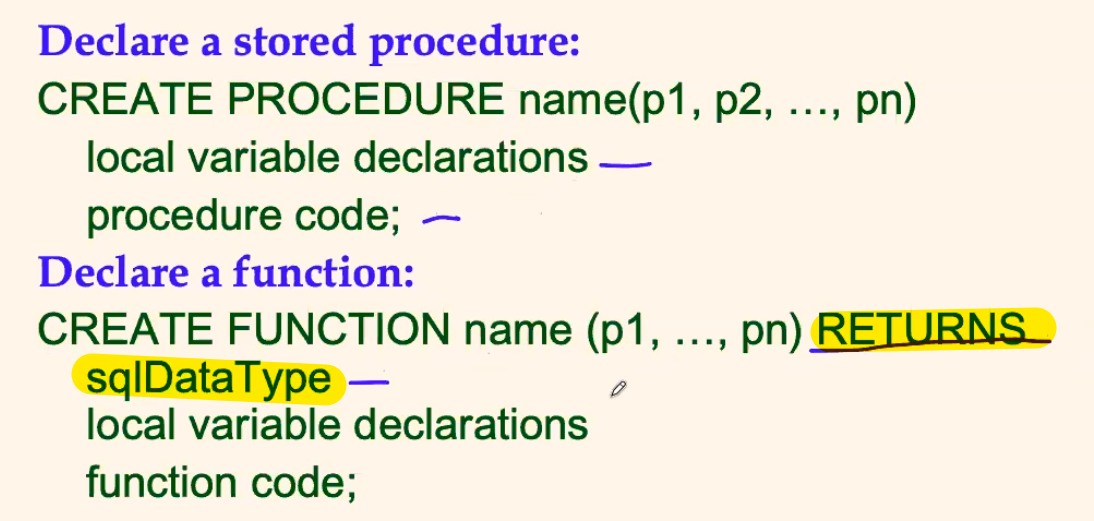
Triggers - Server Programming
A procedure that starts automatically when a specified change occurs
- Changes could be:
INSERT,UPDATE,DELETE(others too)
Triggers
Think of triggers having three parts (ECA Components)
- Event associated with the trigger
- Condition (optional) – should it be fired?
- Action – the trigger procedure/function/what should be executed
Can be attached to both tables and views
Some possible timings that you can specify for a trigger to happen is
where:
beforemeans before the evaluation of theeventaftermeans afterinstead ofmeans, exactly at the point when trigger condition is met, stop the execution of your program, and start triggersynchronousmeans execute the trigger right after your program/eventasynchronousmeans execute the trigger asynchronously when the condition is met. So it does not stop the execution of your program
However, sometimes you might need to consider:
-
Trigger should happen at what granularity of invocation? Record (row) level or statement level?
- A row-level trigger is invoked once for each row affected by the triggering statement
- A statement-level trigger is invoked only once, regardless of the number of rows affected by the triggering statement
-
Hard to determine chain of events
- cascading triggers
- recursive invocation (potentially endless) of the same triggers possible
-
Transactional issues; trigger could be seen as
- part of the triggering statement or
- independent action
i.e. should the trigger be aborted if the transaction is aborted?
Difference between Constraints and Triggers
- Constraints describe what the database’s state is (they have to be
TRUEor else … )
- The effects of constraints are known – no mystery if a constraint is violated (gives error)
- They do not change the state of the database
- Triggers are programs - very flexible mechanism
- theoretically, you might not be entirely sure what happens when a trigger is executed
Order of Execution
Reminder
- Triggers can be configured at many different timings
- The granularity of trigger could be row level of statement level
- Statement-level BEFORE triggers
- fire before the statement starts to do anything
- Statement-level AFTER triggers
- fire at the very end of the statement
- Row-level BEFORE triggers
- fire immediately before a row is operated on
- Row-level AFTER triggers
- fire at the end of the each row operation (before statement-level AFTER triggers)
- Row-level INSTEAD OF triggers (on views only)
- fire immediately as each row in the view is identified as needing to be operated on.
If more than one trigger is defined for the same event/relation
- execute them In alphabetical order by trigger name!
Condition in Triggers
Reminder
- Recall that a triggers having three parts (ECA Components)
- Event associated with the trigger
- Condition (optional) – should it be fired?
- Action – the trigger procedure/function/what should be executed
- Now, we want to look at what conditions can be specified
Commonly:
`WHEN Condition
If it exists, the condition needs to be true for the trigger to fire
- e.g.,
WHEN time-of-day() > 9:30:05Only for row-level
AFTERtriggers, the trigger’s condition can examine the values of the columns of
- the OLD row (before an UPDATE or DELET)
- and the NEW row (after an UPDATE or DELET)
in order words, you can use the parameters
oldandnew:
- e.g.
WHEN new.salary > 10*old.salary.
Examples of Triggers
Syntax:
CREATE TRIGGER name
[BEFORE | AFTER | INSTEAD OF ] event_list ON table
[WHEN trigger_qualifications]
[FOR EACH ROW procedure |
FOR EACH STATEMENT procedure ]
where:
- Event ->
event_list ON table- activates the trigger
- Condition ->
WHEN trigger_qualifications- should it be fired?
- Action ->
[FOR EACH ROW procedure | FOR EACH STATEMENT procedure ]- the actual procedure to run
Then some examples would be:
For Example
CREATE TRIGGER init_count BEFORE INSERT ON Students
DECLARE count INTEGER; /* like a GLOBAL VARIABLE */
BEGIN
count := 0
END
where:
-
the Event is
BEFORE INSERT ON Students -
the Action is:
DECLARE count INTEGER; BEGIN count := 0 END -
the
DECLARE count INTEGER;is like a global variable declared
and then
CREATE TRIGGER incr_count AFTER INSERT ON Students
WHEN (NEW.age < 18)
FOR EACH ROW
BEGIN
count := count + 1;
END
For Example
If we want to populate data into another table automatically:
CREATE TRIGGER stats AFTER INSERT ON Students
REFERENCING NEW TABLE Stats /* if we want to modify/deal with other tables */
FOR EACH STATEMENT
INSERT INTO Stats
SELECT age, AVG(gpa)
FROM Students
GROUP BY age
where:
- now, after you insert new data into
Students, the tableStatswill also be populated
Normal Forms
This section talks about Schema Refinement and Normal Forms.
The Evils of Redundancy
- Redundancy is at the root of several problems associated with relational schemas:
- redundant storage, insert/delete/update anomalies
- Main refinement technique: decomposition (replacing ABCD with, say, AB and BCD, or ACD and ABD).
- in the end, we should have tables with a single, clear functional dependency.
Functional Dependency
Functional Dependency
- A functional dependency $X \to Y$ holds over relation $R$ if, for every instance $r$ of $R$:
- i.e. given two tuples in $r$, if the $X$ values agree, then the $Y$ values must also agree. (X and Y are sets of attributes.). An example would be $X$ being the primary key of a table $r$
- In fact, this means if $K$ is a candidate key of $R$, then $K \to R$
Note that the above notation $X → Y$ is read as:
- $X$ functionally determines $Y$
- or $Y$ functionally depends on $X$
For Example
Consider the schema:
- Consider relation obtained from
Hourly_Emps (ssn, name, lot, rating, hrly_wages, hrs_worked)
We denote this relation schema by listing the attributes: SNLRWH
- This is really the set of attributes
{S,N,L,R,W,H}
Then some functional dependencies include
ssnis the key: $S \to SNLRWH$ratingdetermineshourly_wages: $R \to W$
Note
- the reverse is often not true, i.e. you might not have $W \to R$
- if $R = 10 \to W =100$, and $R=11 \to W=110$
- obviously, reversing does not work
For Example: Functional Dependency
Instead of having:
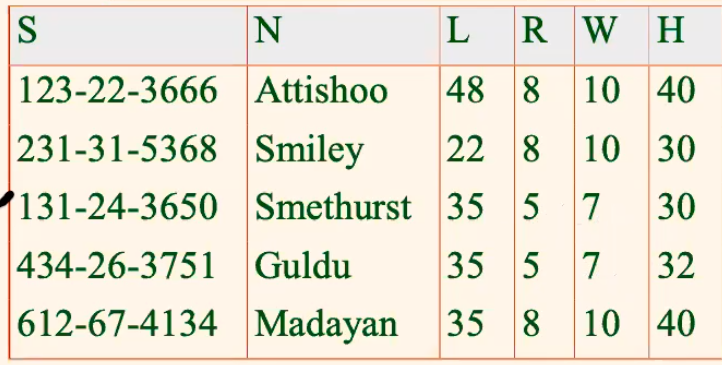
where:
- $R\to W$, so that $W$ actually does not depend no $S$, but $R$!
then you have the following problem due to redundancy
Update anomaly:
- Can we change $W$ in just the1st tuple of $SNLRWH$? (without messing up the mapping $R\to W$)
Insertion anomaly:
- What if we want to insert an employee and don’t know the hourly wage for his rating?
Deletion anomaly:
- If we delete all employees with rating $5$, we lose the information about the wage for rating $5$!
Therefore:
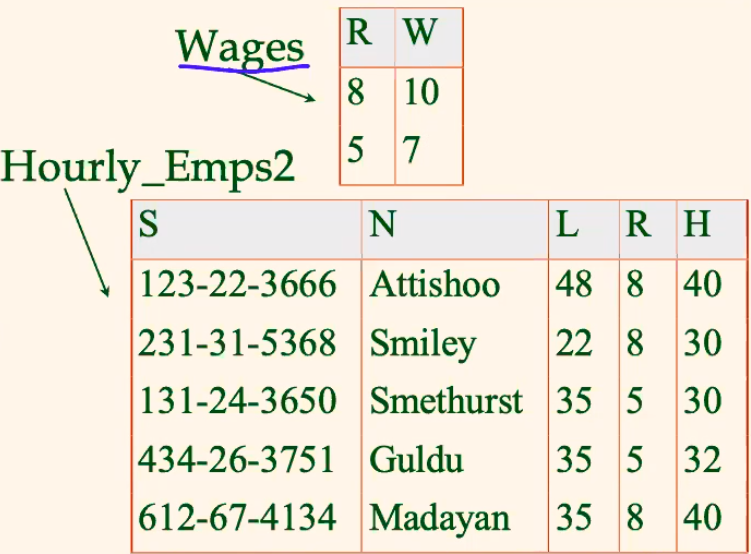
where now:
-
the table makes it clear that: $S \to R$, and then $R \to W$
-
no redundancy and clear functional dependencies
Checking Functional Decomposition
we have decomposed the schema to better forms. To check if it is correct:
perform a
JOINand see if the table matches the original onethe two tables solution means that it must be
- $S \to R$
- $R \to W$
hence two tables. But if $R \text{ and } H\to W$, then the above design would not work
Properties of Functional Dependency
Some obvious ones are
Armstrong’s Axioms
- Armstrong’s Axioms (X, Y, Z are sets of attributes):
- Reflexivity: If $Y \subseteq X$, then $X \to Y$
- e.g. $Y = BC, X=ABC$, then obviously $ABC \to BC$
- Augmentation: If $X \to Y$, then $XZ \to YZ$ for any Z
- (Note: the opposite is not true!)
- Transitivity: If $X \to Y$ and $Y \to Z$, then $X \to Z$
- Following from the axioms are:
- Union: If $X \to Y$ and $X \to Z$, then $X \to YZ$
- Decomposition: If $X \to YZ$, then $X \to Y$ and $X \to Z$
Closure Property
- the set of all FDs are closed.
- recall that closure means if $F$ is the set of FDs, and I apply functional dependencies on the elements of the set, am I still inside $F$? (not getting anything new).
- e.g. $F = {A \to B, B \to C, C D \to E }$ , can you cannot get $A\to E$. Otherwise it is not closed.
- proof see page 9-10 of PPT
For Example

Then, this means that:
- $JP \to CSJDPQV$
- because $JP \to C$, $C \to CSJDPQV$ using transitivity
- and then $SDJ \to JP$
- because $SD \to P$, using augmentation
- and hence that $SDJ \to CSJDPQV$
- because $SDJ \to JP$, $JP \to CSJDPQV$
So I get two primary keys
- $JP \to CSJDPQV$
- $SDJ \to CSJDPQV$
For Example: Closure
Consider:

then we can get: $$
F_A^+ = { A \to A, A\to BE, A\to ABCDE}
\[where: - $A \to ABCDE$ is derived from the given FDs in the set $R$, since - $A \to ABE$ is clear, - **then using** $(2)$, means $A \to ABCE$, - **then using** $(3)$, means $A \to ABCDE$ ## Boyce-Codd Normal Form > **Why Normal Forms** > > - If a relation is in a certain normal form (BCNF, 3NF etc.), it is known that certain kinds of problems are avoided/minimized. > **BCNF** > > - relation $R$ is in BCNF if, for all $X\to A$ in the close of $F$ (i.e. $F^+$) > - $A \in X$ (called a trivial FD), > - or $X$ contains a *key* for R (i.e., X is a superkey) > > - In other words, R is in BCNF if the **only non-trivial FDs** that hold over R are **key constraints**. > - i.e. only dependencies are the *single primary key* ## Third Normal Form This basically is the most used form for designing database. - though there are still some *redundancy* > **Third Normal Form** > > - Relation $R$ with FDs $F$ is in 3NF if, for all $X \to A$ in $F^+$ > - $A \in X$ (called a trivial FD), > - $X$ contains a *key* for R (i.e., X is a superkey) > - **$A$ is part of some key for $R$.** note that: - obviously if $R$ is in BCNF, it is also in 3NF. ## Problems with Decomposition > **Three Problems with Decomposition** > > 1. Some queries become more *expensive*. > 2. **Lossless-join**: > - Given instances of the decomposed relations, we may not be able to *reconstruct the corresponding instance* of the original relation! > 3. **Dependency preserving**: > - Checking some dependencies may require joining the instances of the decomposed relations. note that: - 3NF does not have those problems, but BCNF will - but 3NF might be redundant, yet BCNF will not ### Lossless Join Decomposition > **Lossless Join** > > - Decomposition of $R$ into $X$ and $Y$ is lossless-join w.r.t. a set of FDs $F$ if, for *every instance $r$ that satisfies $F$*: > - $\pi_x(r) \bowtie \pi_y(r) = r$ > - i.e. we can reconstruct $r$ if decomposed in $X,Y$ *For Example* The following decomposition is *not lossless* 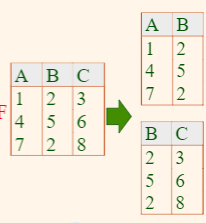 since joining back gives 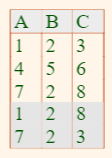 ### Dependency Preserving Decomposition > **Dependency Preserving** > > - (Intuitive) If $R$ is decomposed into $X$, $Y$ and $Z$, and we enforce the FDs that hold on X, on Y and on Z, then all FDs that were given to hold on R must also hold > - i.e. if $R$ has FDs of $F^+$, then it must be that the union $F_X^+ \cup F_Y^+ \cup F_Z^+ = F^+$, so that functional dependencies are not *lost* *For Example* - relation $ABC$, with functional dependencies $A \to B, B\to C, C\to A$ If we have decomposed into - $AB$, $BC$ then we see that the functional dependency: - $C \to A$ *is not preserved* # Object Relational DBMS First, let us look at Object Oriented vs Relational <img src="/lectures/images/2021-04-22-COMS4111_Intro_to_Databases/Snipaste_2021-03-20_12-59-10.png" style="zoom: 67%;" /> so that most of them is not there. Now, the **implemented Object-Relational DBMS** have <img src="/lectures/images/2021-04-22-COMS4111_Intro_to_Databases/Snipaste_2021-03-20_13-00-30.png" style="zoom:67%;" /> *For Example* In ORDBMS, then Schema **may** look like this <img src="/lectures/images/2021-04-22-COMS4111_Intro_to_Databases/Snipaste_2021-03-20_13-02-03.png" style="zoom: 33%;" /> and the SQL **may** look like: <img src="/lectures/images/2021-04-22-COMS4111_Intro_to_Databases/Snipaste_2021-03-20_13-05-50.png" style="zoom:33%;" /> where the new functionalities would be: - **User-defined functions** (e.g., sunset) and operators (e.g., |20|) - **Composite data types** (e.g., document, point) - **Performance**: a query optimizer aware of “expensive functions” like sunset ## ORDBMS DDL Statements Most straightforward by an example: <img src="/lectures/images/2021-04-22-COMS4111_Intro_to_Databases/Snipaste_2021-03-20_13-20-52.png" style="zoom: 67%;" /> where: - `REF IS SYSTEM GENERATED` means that you want the *system to generate reference ids*, so that you can "dereference" it and *find the object* - `CREATE TABLE Theaters OF theater_t REF is tid SYSTEM GENERATED ` means the table *contains rows of `theater_t`*, and the reference (column) of each object is called `tid`, which is `SYSTEM GENERATED` - `CREATE TABLE Nowshowing (film integer, theater ref(theater_t) SCOPE Theaters,...) ` means that - `theater ref(theater_t)` means a column `theater` *contains a pointer/reference to ANY object of type `theater_t`* - `theater ref(theater_t) SCOPE Theaters` means that column can **only point** to `theater_t` objects in the table `Theaters` - ` stars VARCHAR(25) ARRAY [10], ` means an array of size 10 containing `VARCHAR(25)` - then accessing the first name would be of table `File f` by `f.stars[0]` in a query ## Inheritance > **Note** > > - in the end, the ORDBMS combines: > - the *structuring* idea from Objected-Oriented > - the actual queries/storage from the relational DBMS > - so that in the end, everything is *still about tables/sets* *For Example* <img src="/lectures/images/2021-04-22-COMS4111_Intro_to_Databases/Snipaste_2021-03-20_13-30-25.png" style="zoom: 67%;" /> where: - `UNDER theater_t (menu text)` means **extending**`theater_t` type, and *adding an attribute* `menu` of type `text` - this is structure inheritance - `CREATE TABLE Theater_Cafes ... UNDER Theaters` means the table `Theater_Cafes` is a **subset** of the table `Theaters` - hence, by default, queries over `Theaters` are **also evaluated over `Theater_cafes`** (and all other potential subclasses at the time of evaluation) - if you don't want to do that, you can use `ONLY` # Storage and Indexing This section is about **performance**. First, we need to understand how this is stored. > **Main memory (RAM)** –while fast > > - It is volatile –we lose data between runs > - 100x more expensive than HD, 20x than SSD > > **Solid state drive (SSD, flash)** > > - Limit max capacity (2-4TB?) > - faster than HD, more durable than HD, no noise **Typical storage hierarchy**: 1. Main memory (RAM) for currently used data. 2. (Solid state, not widely used yet but it will soon) 3. Disks for the main database (secondary storage). 4. (In the past) Tapes for archiving older versions of the data (tertiary storage); not used for the operational part of the DB. ## Hard Disk > **Components of a Disk** > > <img src="/lectures/images/2021-04-22-COMS4111_Intro_to_Databases/Snipaste_2021-03-27_11-45-52.png" style="zoom:50%;" /> > > where: > > - **read/write head** writes and reads data from platters > - only one of the heads will read/write at any time > - the *smallest unit of reading is a Block size* - a multiple of sector size (which is fixed). > - **platters** spin (e.g. at 90rps) > - **arm assembly** is moved in or out to position a head on a desired track. Tracks under heads make a cylinder(imaginary!). Now, for **software** such as DBMS, (e.g. Oracle), we use a **page** as the minimal unit of data access > *Reminder* > > - A **page** is a multiple of disk blocks – the page size is determined by the DBMS or any other software using disks e.g. OS. > - Examples: 4K, 8K, 16K. > - *READ*: transfer data (a number of *disk blocks*) from disk *to main memory (RAM).* > - *WRITE*: transfer data (a number of *disk blocks*) from RAM *to disk.* > - Both are **high-cost operations**, relative to in-memory operations, so must be planned carefully! We care about this because: - Unlike RAM, time to retrieve a disk page varies **depending** upon **location** on **disk**. - Therefore, relative placement of pages on disk has **major impact on DBMS performance!** ### Accessing a Disk Page > **Time to Access a Disk Block** > > - Time to access (read/write) a disk block: > 1. **seek time** (moving arms to position disk head on track) + > 2. **rotational delay** (waiting for block to rotate under head) + > 3. **transfer time** (actually moving data to/from disk surface) **Seek time** and rotational delay **dominate**. - **Seek time** varies from about 1 to 20msec - Rotational delay varies from 0 to 10msec - Transfer rate is about 1msec per 4KB page So we want to optimize for **performance**, so we want to: - if possible, attempt to *reduce seek time* - **reduce number of disk access `I/O`** *For Example* > Usually, we assuming that a **page in OS** correspond to **continuous blocks in disk** If we want to read *one page* of`page_id=1` in **one request/system call** - the # disk access would be 1 If we want to read *8 pages* starting from `page_id=5` in **one request/system call** - still 1 disk access, since data is **contiguous** If we want to read *8 pages* starting from `page_id=5` in **eight request/system calls** - then 8 disk accesses If we want to read the entire database in **one request/system call** - then there will be **many disk accesses**, since the database is of course not an entire, consecutive pages in the hard disk --- > **Note** > > - For a sequential scan, pre-fetching several pages at a time is a big win! ## Disk Space Management **Lowest layer** of DBMS software **manages space on disk**. **Higher levels** call upon this layer to: - `allocate(int n)`: **allocate** `n` pages, return the page id of the first page of the sequence of `n` pages - i.e. `allocate(8)` would give you the first page of *eight consecutive pages*, yet `8*allocate(1)` would *not be guaranteed* to give you eight consecutive pages - `deallocate(int pid, int n)`: **free** `n` consecutive pages starting at page id `pid` Additionally, there is of course a **"page cache"**: <img src="/lectures/images/2021-04-22-COMS4111_Intro_to_Databases/Snipaste_2021-03-27_13-05-32.png" style="zoom: 80%;" /> where: - database uses its own "page cache", though the idea is the same - it is not using the OS's page cache, in order for *portability and compatibility* on different devices - additionally, if we implement this on a *database level*, we can also: - **pin** a page in buffer pool, **force a page** to disk (important for implementing CC & recovery) - **adjust replacement policy**, and pre-fetch pages based on access patterns in typical DB operations ### Page Formats: Variable Length Records This is how the DMBS manages its actual data in pages: <img src="/lectures/images/2021-04-22-COMS4111_Intro_to_Databases/Snipaste_2021-03-27_13-25-16.png" style="zoom:50%;" /> where there are **three approach** *identify* memory with a database record. When a new database record is inserted 1. a **new logical id** will be created (which maps to the physical address), then the id is the *logical id* - so to find the actual data, you need to do **two things**, translate the mapping and access the address - however, this is **more flexible** since if you moved the data, you only need to change the *mapping* 2. the id of the record will be the *physical address* - to find the actual data, you just need to do **one thing** - however, this is **less flexible** (as id cannot change) if you have moved some data 3. the id is a **combination of the actual page id and a slot number** (basically an offset) - this is the **diagram in the above**, you use `rid` for id - then, you have **both the physical address of page**, but also **flexibility WITHIN the page** (i.e. you can change the offset/slot number) ### Files of Records Page or block is OK when doing I/O, but **higher levels** of DBMS operate on **records**, and **files of records.** > **File:** > > - A *collection of pages*, each containing a collection of records. > - Must support the ability to: > - insert/delete/modify record > - read a particular record (specified using record id) > - *scan* all records (possibly with some conditions on the records to be retrieved) > - e.g. `select ... from ...` Then, the questions comes down to how the DMBS: - **stores files of records** (i.e. collection of pages that contains your data) in the memory ### Unordered (Heap) File As **file** grows and shrinks, disk pages are allocated and de-allocated. To support record level operations, we must: - keep track of the pages in a file - keep track of free space on pages - keep track of the records on a page (e.g. via `rid`) *Example: Heap File Implemented as List* <img src="/lectures/images/2021-04-22-COMS4111_Intro_to_Databases/Snipaste_2021-03-27_13-35-01.png" style="zoom:50%;" /> --- *Example:* <img src="/lectures/images/2021-04-22-COMS4111_Intro_to_Databases/Snipaste_2021-03-27_13-40-25.png" style="zoom:67%;" /> --- > **Note** > > - In both of the above implementation, finding a *specific page* requires **$O(N)$ Disk Accesses**, where $N=\text{number of pages of the file/a header}$ ## Index File > **Search Key** > > - It has nothing to do with a primary key/any key in a table > - It is the **key that DBMS can then use to perform search faster** > - e.g. you want to look up students with `gpa>3.0`, then you should build an **index with search key =`gpa`** > - Any subset of the fields of a relation can built to be the search key for an index on the relation. > **Index** > > - An **index** on a file speeds up selections **on the search key fields** for the index. > - An index contains a collection of **data entries**, and supports efficient retrieval of **all data entries `k*`** with a **given key value `k`.** > - for example, `k=3.0` could have data entry `k*` which contains *all records of student with `gpa=3.0=k`* *For Example* If you want find *all students with `gpa>3.0`*, then 1. build an index on the search key = `gpa` 2. do a binary search (assuming index is sorted) 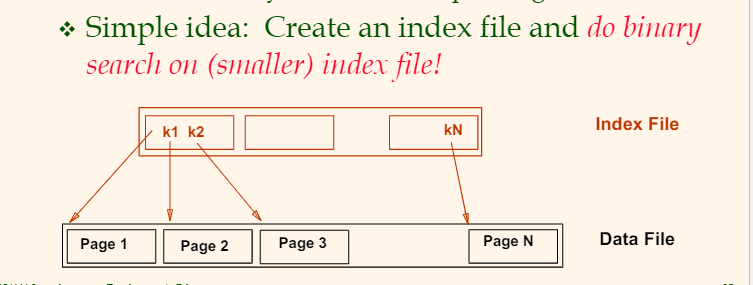 where now the **search operation will be $O(log(N))$ of Disk Accesses!** ### Hash-Based Indexing <img src="/lectures/images/2021-04-22-COMS4111_Intro_to_Databases/Snipaste_2021-03-27_14-09-49.png" style="zoom:50%;" /> where: - we have a hash function $h(k)$, which takes a parameter $k=key$:\]h(k) \text{ mod } N
\[- then the Disk Access is in $O(M)$ for **look ups**, where $M$ is the **number of overflow pages in a bucket** - in general, this will be small ($O(M) \approx 1.2$), but we can optimize anyway by: - *increase the number of buckets* - hash function that *evenly distribute the entries* > **Advantage** > > - In other words, Hash-Based indexing is *really fast for equality searches* > > **Disadvantage** > > - this is bad if we need $\le$ or $\ge$, because we have eventually *lost the $key$ information into $h(k) \text{ mod } N$* > - therefore, we would need $O(N)$ again for range searches to look at *entries in every bucket* ### B+ Tree Indexes > *Reminder: Binary Tree* > > - anything on the **left** is smaller than the parent, and the **right** larger or equal to the parent > - since this *might be be balanced*, the tree could just have a really large height > **B+ Tree** > > - the idea is that each **non-leaf node contains** > > 1. a list of `(pointers, key)` to the children, where `key` is the key of that children. Also called the **index entry** > > 2. the list inside each node is **sorted** > > <img src="/lectures/images/2021-04-22-COMS4111_Intro_to_Databases/Snipaste_2021-03-27_14-52-41.png" style="zoom: 67%;" /> > > - the **leaf node contains** > > - the *actual data entry* (i.e. records/pages) > > - this tree is **balanced** > > <img src="/lectures/images/2021-04-22-COMS4111_Intro_to_Databases/Snipaste_2021-03-27_14-29-56.png" style="zoom:50%;" /> > > notice that the **leaf nodes are also connected**, so that it will be easy to implement $\ge$ or $\le$ search *For Example* <img src="/lectures/images/2021-04-22-COMS4111_Intro_to_Databases/Snipaste_2021-03-27_14-34-13.png" style="zoom: 67%;" /> where notice that: - each `p_key` in the **parent entry** point to the child node who **only contains `key < p_key`** - then the Disk Access is `O(levels)`, in **real life**, this will be $O(level) \approx 3$ (**this will be for equality look up**) - assumes that each node is of size `8K`, and each pair of `(pointer, key)` is `8B`, then we have in most cases `3` levels > **Note that** > > - the `index_entry` **only contains**: > 1. the key > 3. the pointer to next level > > It does **not** contain the data record/row > - Therefore, you can technically find information **on the last level** > > - so that Range Queries become easy > **Advantage** > > - For each **equality search**, in real life, `O(3)` **Disk Access** (i.e. how many times we need to go down) > - binary search in the list is done in *computer*, so does not count towards Disk Access > - For each $\le$, $\ge$ **search**, we would have `O(3)+O(M)`, for `M` being the actual number of entries satisfying the predicate > - e.g. if we needed `age > 24`, and there are `10` entries for that, then we have `3+10=13` Disk Accesses ### Primary and Secondary Index The above did two algorithms did not specify **how the index entry stores the data records/address of the data record** in fact, the two approaches are: 1. **Primary Index**: index entry `k*` contains the data 2. **Secondary Index** the index entry `k*` contains the `rid` of the data (i.e. the pointer to it) <img src="/lectures/images/2021-04-22-COMS4111_Intro_to_Databases/Snipaste_2021-04-02_22-35-14.png" style="zoom: 50%;" /> where: - for example, if for a entry we have `k=3`, then `data_record = [actual record of that Student with gpa=k=3]` > **Advantage for Primary Index** > > - Fast, *saves one Disk Access* as the data is already there > > **Disadvantage for Primary Index** > > - Makes the *data entries large* > **Advantage for Secondary Index** > > - Makes the *data entries small* > > **Disadvantage for Secondary Index** > > - Need *one more extra Disk Access* ## Clusters Clustering requires some **mathematical order** present in the data records > **Clustered Index** > > - If **order of data records** is the same as, or `close to’, **order of data entries**, then called clustered index. *For Example*: <img src="/lectures/images/2021-04-22-COMS4111_Intro_to_Databases/Snipaste_2021-03-27_15-22-27.png" style="zoom: 67%;" /> In general, **clustered index** would be faster, because: if I am fetching `key=pga>=3,0`, and that we **know there are $10$ data records that matches that** - having clustered index means we have `3` Data Access + **`1` System call** to fetch all the $10$ **consecutive data records** - e.g. if it happens that the 10 records are on the same page, then `1` System call = 1 Disk Access here - having un-clustered index means we have `3` Data Access + **`10` System** calls/Disk Accesses to fetch since they are **discontinuous** ## Composite Indices > **Composite Keys** > > - Composite Search Keys: Search on a **combination of fields.** > - for example if we have search key = `<sal, age>` > - then **Equality query** may look like `age=20 AND sal=75` > - **Rane query** may look like `age=20` or `age=20 AND sal > 10` > - Data entries in **sorted by search key** to support range queries. > - e.g. by Lexicographic order, or Spatial order. <img src="/lectures/images/2021-04-22-COMS4111_Intro_to_Databases/Snipaste_2021-03-27_15-29-16.png" style="zoom:50%;" /> <mark>TODO</mark> this should be data entries? Yes, should be data entries > **Note** > > - a data entry with key `<sal, age>` would be *different from* the key `<age, sal>`, where for the former, `sal` is **compared first**, and then `age` ## Performance Summary <img src="/lectures/images/2021-04-22-COMS4111_Intro_to_Databases/Snipaste_2021-03-27_15-36-53.png" style="zoom:67%;" /> remember the above is about **number of Disk Accesses** ## Index Selection Guidelines 1. Attributes in `WHERE` clause are candidates for index keys - **Exact** match condition suggests **hash** index. - **Range query** suggests **tree** index. - Clustering is especially useful for range queries; can also help on equality queries if there are many duplicates. 2. Before creating an index, must also consider the impact on updates in the workload! - Trade-off: Indexes can make queries go faster, **updates slower**. Require disk space, too. > **Note** > > - Try to choose indexes that benefit as many queries as possible. Since **only one index can be clustered per relation**, choose it based on important queries that would benefit the most from clustering. ## Index Syntax ```sql CREATE [UNIQUE] INDEX index-name ON Students (age, gpa) WITH STRUCTURE = [BTREE | HASH | ...] [WHERE <predicate>] ``` where: - `[WHERE <predicate>]` means that only if the record *matches the predicate*, it will be placed into the `INDEX` - `CREATE [UNIQUE] INDEX` means that the *entry of a key will only contain ONE record* # Query Evaluation Optimization If we want to keep **all of our data in a sorted manner**, when one storage we want to use would be: - B+ Tree with *primary index* storage (not secondary index since that would no be the storage anymore) Keeping data in some order will **help us later with query optimization** > **Query Plan** > > - how we should compute that query, e.g. in what order > **Overview of Query Evaluation** > > 1. For a given query, **what plans** are considered? > - obviously not all of them, which would take very long > 2. How is the **cost of each plan** estimated? > - the aim here is to quickly *estimate* > > **Ideally**: Want to find best plan. > > **Practically**: Avoid worst plans! Before discussing the System R Approach, lets look at something else related. Some common techniques for *evaluating relational operators* could be: > **Common Techniques of Evaluating/Computing Queries** > > - **Indexing**: if there is a `WHERE`, then we should use some sort of indexing to get the data back > - **Iteration**: sometimes, we need to scan all tuples/rows > - **Partitioning**: by sorting or hashing, we can partition the input tuples and replace an expensive operation by similar operations on smaller inputs > - i.e. breaking up the query into smaller, more efficient parts Note the above talks about how the **query itself might be evaluated** ## Statistics and Catalogs Before going to talk about optimization, we need to know **what is available for us** in the DBMS > **System Catalogs** > > This is maintained by the DMBS, and typically contain at least: > > - `# tuples` (NTuples) and `# pages` (NPages) for each relation. > - `# distinct key values` (NKeys) and NPages for each index. > - Index height, low/high key values (Low/High) for each tree index. > > Catalogs updated **periodically**. > > - Updating whenever data changes is too expensive; lots of approximation anyway, so *slight inconsistency is ok*. > - Usually meta information might not be updated timely ### System Catalogs Basically, they are **system tables** that store additional information on the relations you have. > **System Catalogs** > > For each index, it **stores**: > > - structure (e.g., B+ tree) and search key fields > > For each relation, it **stores**: > > - name, file structure (e.g., Heap file) > - attribute name and type, for each attribute > - index name, for each index > - integrity constraints > > For each view, it **stores**: > > - view name and definition > > **Plus** statistics, authorization, buffer pool size, etc. *For Example* <img src="/lectures/images/2021-04-22-COMS4111_Intro_to_Databases/Snipaste_2021-04-02_21-40-28.png" style="zoom:50%;" /> where: - `rel_name` means in *which table is the `attr_name` belonging to* - usually, those tables will also contain *data about themselves* ## Access Path > **Access Path** > > - an access path is about *how to actually retrieve tuple/rows* of a table > - e.g. should I scan through everything in the Heap, or should I index into a Hash Table? > - i.e. how to *figure out where the data is* *For Example* **(B)Tree Indexes** for with primary/secondary indexes built on a *composite search key* `<a,b,c>` - then, every time when we are querying a *prefix in the search key*, for example `WHERE a=5 AND b=3`, we **can use** it - if we are querying `WHERE a=5 AND c=3`, then this indexing **cannot be used** **Hash Index** index built on a *composite search key `<a,b,c>`* - then, the only query that we can use here is `WHERE a=5 AND b=6 AND c=7` - all the rest queries **cannot be used** --- > **Summary** > > - B+ Tree works when a `WHERE` query involve only attributes in a *prefix of the search key* > - Hash Table works when a `WHERE` query involves *every attribute in the search key* ### Conjunctive Normal Form One problem that we avoided in the example above is for *queries using `OR`* Consider: ```sql WHERE (day<8/9/94 AND rname=‘Paul’) OR bid=5 OR sid=3 ``` To "simplify" this, we can **convert it to conjunctive normal form (CNF)** - i.e. where each term is connected by `OR` only ```sql WHERE ( day<8/9/94 OR bid=5 OR sid=3 ) AND (rname=‘Paul’ OR bid=5 OR sid=3) ``` ## (Selection) Most Selective Access Path This is basically to deal with **selection $\sigma$**. Then, one idea of optimization is to find the **most selective access path** > **Most Selective Access Path** > > - An index or file scan that we estimate will require the **fewest page I/Os** > - i.e. *fewest steps to compute that* -> fewest records returned = easier to deal with later > - Terms that match this index **reduce the number of tuples retrieved**; other terms are used to discard some retrieved tuples, *For Example* If we have something generic:\]\sigma_{T_1 \land T_2 \land T_3 \land …}(\text{Some Table})
\[where: - matching $T_1$ has only **one records** - matching $T_2$ has 100 records Then obviously we should **start with evaluating $T_1$**, which is the **most selective access path** in this case - then you might just need *only a few Disk Access to fetch records that match $T_1$,* and that's it --- > **In Summary** > > This means that we need to think about and **estimate**: > > - How **fast the $T_1$ can be evaluated** > - How **big** does the result look like **after evaluating $T_1$** ### Using an Index for Selection Consider the example: <img src="/lectures/images/2021-04-22-COMS4111_Intro_to_Databases/Snipaste_2021-04-02_22-39-14.png" style="zoom:50%;" /> where we need to find `sname` start with `A` or `B` basically 1. we go down the B Tree, e.g. the Left Most Data Record 2. Look up our System Table to know if it is a *primary/secondary index* 3. Range query *towards right* until a name starting with `C` > **Note** > > - if we don't have a B+-Tree, or the search key is *not `sname`*, then we **cannot/should not** use it for selection Now, we know what the *access path* looks like. We now need to think/estimate the **size of return values** > **Approximation for Size of Return Values** > > - For this course, the **only strategy** we will use is **assuming uniform distribution** Therefore, in this case, the *estimated size* is:\]\frac{2}{26}=\frac{1}{13} \approx 10\% \text{ of the total number of records}
\[Then, say we have 10,000 tuples on 100 B-tree pages: - with a *clustered* index, cost is little more than 100 I/Os; - if *un-clustered*, up to 10,000 I/Os! ## Projection Optimization Now, we wan to **optimize projection** $\Pi$ *For Example*: Consider the query: ```sql SELECT R.sid, R.bid FROM Reserves R ``` The **only** way to optimize is: - if we happen to have a **Hash Table/B-Tree whose search key is `<sid, bid>`**, then I can **just look at/scan the search key** without needing to read the record - i.e. we are only *scanning through the search keys*, this is also called the **Index Only Evaluation** - Basically, this is optimization because the *number of total pages of data records in Heap* $>$ *number of total pages of search keys in Heap* Otherwise, we need to *scan the entire Heap* --- Now, what is **`distinct`** is specified? ```sql SELECT DISTINCT R.sid, R.bid FROM Reserves R ``` if we scan the entire Heap, this will be costly because: - we need to somehow figure out if each record *is duplicated*, which can be done by *sorting the records in the end*, but overall costly **One** ways to optimize is to use a *Hash Table*: 1. create a Hash Table with search key/bucket `<sid, bid>` 2. as we fetch each record from Heap, we dump it into the Hash Table 3. In the end, we just need to do a **Index Only Evaluation** on the Hash Table we created ## Join Optimization > *Reminder* > > - A join looks like $R \bowtie_{i=j} S$, and we needed to basically do a **cartesian product** like: > > ```python > for each tuple r in R: > for each tuple s in S: > if (r.i == s.j): > add <r, s> to result > ``` > > so basically the cost is huge. *For Example*: Let us have two tables $R$, and $S$, where: - $M_R$ is the *number of pages in $R$* - $M_S$ is the *number of pages in $S$* - $p$ is the *number of data records/tuples per page* Then: - the brute force no-index JOIN will need:\]M_R + [(M_R \times p) \times(M_S \times p)]
\[since we need to 1. read in one of the entire table 2. read *one record at a time* for this algorithm for search However, since the idea is to **add the result if there is a MATCHING** from a record in table R and a (or many) record in S, we could do: - if we have a <mark>B-Tree indexing</mark> on the column of *one of the relation*\]M_R + [(M_R \times p) \times 3]
\[- this makes sense because for each record of $R$, we just needed *$3$ Disk Access (B-Tree traversal)* to find out if there is an **equivalent** entry on $S$ - we *only needed to read the entire table $R$* ($M_R$ Disk Accesses since we read by page) in the beginning, and THEN do the search. - if we have a <mark>Hash Table</mark> indexing, then obviously:\]M_R + [(M_R \times p) \times 1]
\[> **Note** > > - Since each record on $R$ could match *multiple records* on $S$, then clustering can *still help even if it is equality search* > - if clustered, then all records of `<i=1, j=1>` are close to each other, so fetching them is easy $\approx 1$ Disk Access > - if un-clustered, still need to look at *each `RID`*, so more Disk Accesses are needed > - Since the above provides a formula, we can **basically estimate the I/O cost using the above** ### Sort-Merge If the two tables $S$ and $R$ are *sorted*, we can do the following: 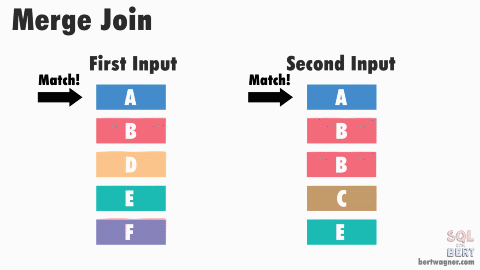 where we have *two pointers*: - if the pointer on the Left Table is on value **smaller than** the pointer on the Right Table, move the left (increase it) **until hit** - if the pointer on the Left Table is on value **large than** the pointer on the Right Table, move the right (increase it) **until hit** Therefore, the cost is (on **average**):\]M_S + M_R
\[since we just needed to scan the records *per page of both table*, no need to Disk I/O it per record, so cost is $M_S + M_R$ In general, if we **include the cost of sorting**\]N\log(N) + M\log(M) + (N+M)
$$
Worst Case Scenario
if we happen to have each row of first table matching all entries of second table, then the cost is actually: $$
M_S \times M_R
$$
but then the cost of sorting is none
In practice
We can use the approximation, since this is happening commonly in reality: $$
3 \times N + 3 \times M + (N+M)
$$
in fact, the more often case is that you have indexes built on both tables, but the tables themselves are not sorted
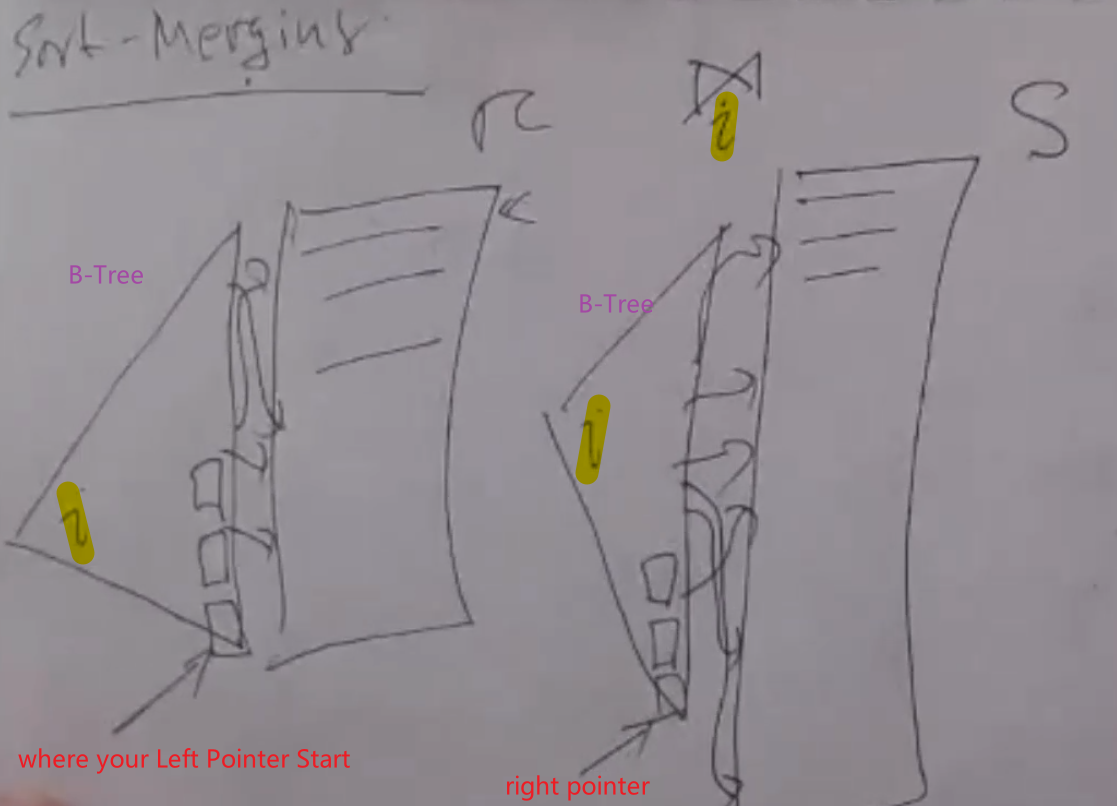
where the sorting is basically already one in the data entries, then the cost is (best case) $$
\text{total # pages of Left B-Tree’s Leaf Nodes } + \text{ total # pages of Right B-Tree’s Leaf Nodes}
$$
Take away message
- if we have some sort of index, we can always find a way to speed up the
JOINsome way
Reduction Factor
Consider the query:
SELECT attribute_list
FROM relation list
WHERE term1 AND ... AND termk
Reduction Factor
Reduction factor (RF) associated with each
termreflects the impact of the term in reducing result size. $$RF_i=\frac{\text{# records matching term$_i$}}{\text{total # of records}}
\[- for example, if you have something like `WHERE id=1`, then the reduction factor is (*assuming `id` is a primary key*):\]\frac{\text{1}}{\text{total # of records}}
$$
This means that the number of data records returned can be approximated to be $$
\text{# Result} \approx (\text{Max # Tuples}) \times \Pi_{RF}
$$ where:
- $\Pi_{RF}$ means the product of all reduction factors
- Implicit assumption that terms are independent
For Example

where:
- technically, there could be other ways to generate the Relational Algebra Tree as well
The most straight-forward Approach would be:
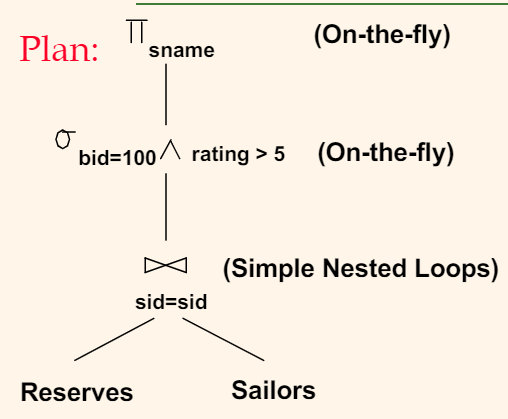
where:
- “on the fly” means we are computing this while computing
JOIN. Therefore, no cost
Cost: $$
\text{Cost} \approx \text{Cost of Join}
\[--- *Alternative Plan 1* <img src="/lectures/images/2021-04-22-COMS4111_Intro_to_Databases/Snipaste_2021-04-03_00-44-51.png" style="zoom:67%;" /> so we basically **decided to do $\sigma$** first **Cost**:\]\text{Cost} \approx( \text{Cost of $\sigma_{bid=100}$} + \text{Write to $T_1$}) + ( \text{Cost of $\sigma_{rating>5}$} + \text{Write to $T_2$})+ (\text{Sort-Merge Join $T_1, T_2$})
\[basically the join would be faster --- *Alternative Plan 2 With Index* <img src="/lectures/images/2021-04-22-COMS4111_Intro_to_Databases/Snipaste_2021-04-03_00-50-32.png" style="zoom: 67%;" /> where: 1. build the Hash Table, and at the **same** time, *do the $\sigma_{bid=100}$* 2. Do the matching/`JOIN` by scanning through `Sailors` and **use the built Hash Table for look up** - at the same time, compute $\sigma_{rating>5}$ > **Note** > > - `Join` column `sid` is a **key** for `Sailors`.–At most one matching tuple. Therefore, **un-clustered index** on `sid` OK **Cost**\]\text{Cost} \approx( \text{Cost of building Hash Table}) + ( \text{Cost of Joining with Hash Table})
\[## Summary 1. A query is evaluated by *converting it to a tree of operators* and *evaluating the operators* in the tree. 2. Two parts to optimizing a query: - Consider a set of alternative **plans**. - Must prune search space; typically, left-deep plans only. - Must estimate **cost** of each plan that is considered. - Must estimate **size** of result AND **cost** for each plan node. # Transactions A transaction is the DBMS’s abstract view of a user program: **a sequence of reads and writes** (because that all what a Database do). This is extremely useful when you are doing some sort of **concurrent execution**, or having some sort of **atomic operation** ## Atomicity of Transactions A transaction might **commit** after completing all its actions, or it could **abort** (or be aborted by the DBMS) after executing some actions. - therefore, either this thing <mark>executed completely</mark>, or <mark>none</mark> > **Atomicity of Transactions** > > - Transactions are executing **all** its actions in **one step**, or **not** executing **any actions at all** > - i.e. all in or nothing > - this is achieved by DBMS logs, which records all actions, so that it can <mark>undo/roll back</mark> the **uncommitted**/aborted transactions. (The idea is exactly the same as *journaling in OS*) <u>*For Example:*</u> Since the log of DBMS is basically the same idea as *journaling OS*, consider the case when: - your DBMS says you have successfully committed - data all in your Cache, not yet flushed to HDD/SSD - powered off your computer Then, technically *data is not there* even if you committed. However, the next time you boot up: - DBMS checks the log, and the **commits** to see if the Disks have it - if not, <mark>redo the committed transactions</mark> so the disk is up-to-date Therefore, it's basically the same idea as *journaling in OS*. ## ACID Properties of Transactions > **Properties of Transactions** > > - **Atomicity**: All actions in the Transactions happen, or none happen > - **Consistency**: If each Transactions is consistent, and the DB starts consistent, it ends up consistent. > - **Isolation**: Execution of one Transactions is isolated from that of other Transactions. > - even if you have *concurrent* transactions, the read/write should be still consistent > - **Durability**: If a Transactions commits, its effects persist. In reality: - the Concurrency Control Manager guarantees **C&I** - the Recovery Manager guarantees **A&D** ## Concurrency Control Consider the two transactions: ``` T1: BEGIN A=A+100, B=B-100 END T2: BEGIN A=1.06*A, B=1.06*B END ``` which *intends to* - first transaction is transferring $100 from B’s account to A’s account. - second is crediting both accounts with a 6% interest payment. <mark>If both are submitted together</mark>, i .e. concurrency, we need to make sure the **net effect** is that these two transactions running <mark>serially</mark> in some order. <u>*For Example:*</u> possible interleaving (i.e., a possible schedule): ```c T1: A=A+100, B=B-100 T2: A=1.06*A, B=1.06*B ``` which has the good net effect. However, the following **would not work** ```sql T1: A=A+100, B=B-100 T2: A=1.06*A, B=1.06*B ``` > In the system's point of view, this is what happens in the wrong case: > > ```sql > T1: R(A), W(A), R(B), W(B) > T2: R(A), W(A), R(B), W(B) > ``` > > basically as a sequence of read and writes. ### Scheduling Transactions A schedule is a basically a series of (scheduled) executions. > **Schedules** > > - **Serial** schedule: Schedule that does not interleave the actions of different transactions. > - simplest thing. Nothing special to do. > - **Equivalent** schedules: For any database state, the effect (on the set of objects in the database) of executing the first schedule is *identical to the effect* of executing the second schedule. > - **Serializable** schedule: A schedule that is equivalent to some serial execution of the transactions. > - A concurrent (**interleaved**) execution of two or more transactions is <mark>correct</mark> if their <mark>execution is serializable</mark> The above defined what it means to have some *correct* concurrent transactions. <u>*For Example*</u> Consider the case: ```c T1: a=read(x); write(x, a+4); Commit // add 4 to x T2: b=read(x); write(x, 10*b); Commit // multiply x by 10 ``` Then, we can have some possible *results*: <img src="/lectures/images/2021-04-22-COMS4111_Intro_to_Databases/Snipaste_2021-04-09_17-43-26.png" style="zoom:67%;" /> where: - the <mark>result</mark> of 1 and 2 are *serializable*, because they are **serial** (in transaction) already $\to$ both are possibly <mark>correct</mark> - thee <mark>result</mark> of 3 is *not serializable*, since the only two possible serialized result is $x=40,x=4$ $\to$ this one is <mark>incorrect</mark> ### Anomalies of Interleaved Execution Basically, this is the problem of: - if you have *simultaneous read/write to the same data* $\iff$ critical section in OS <u>*For Example: Dirty Read*</u> <img src="\lectures\images\typora-user-images\image-20210409175430039.png" alt="image-20210409175430039" style="zoom:67%;" /> where: - we see that the problem is $T_2$ is **reading uncommitted data**, and it has committed the value that is supposed to be **rolled back**! - again, the central cause is that those **transactions are NOT atomic WHEN concurrent** (reminder: think about the `lock`s in OS) --- <u>*For Example: Read-Write Conflicts*</u> <img src="/lectures/images/2021-04-22-COMS4111_Intro_to_Databases/Snipaste_2021-04-09_18-06-42.png" style="zoom: 67%;" /> where: - basically, the problem of isolation. - in short, it is the same problem of $T_1$ accessing some data and $T_2$ changing it without any sort of locks --- <u>*For Example: Overwriting Uncommitted Data*</u> <img src="/lectures/images/2021-04-22-COMS4111_Intro_to_Databases/Snipaste_2021-04-09_18-08-22.png" style="zoom: 67%;" /> where: - again, same problem of two transactions accessing the same data at the same time without locks ### Conflicting Operations From the above examples, we can conclude what are some **conflicted/critical operations**. > **Conflicting Operations** > > - Two operations conflict if it **matters** in which **order** they are performed. > **Read/Write Conflicts** > > - `R(x)`: <mark>conflicts</mark> with `W(x)` > - e.g. [Read-Write Conflicts] $T_1$ does read to `x`, $T_2$ does write to `x`, and $T_1$ does read to `x` > - `W(x)`: <mark>conflicts</mark> with both `R(x)` and `W(x)` > - e.g. [Dirty Read] $T_1$ does write to `x`, and $T_2$ does read to `x` > - e.g. [Overwriting] $T_1$ does a write to `x`, then $T_2$ also does a write to `x` > > All of the above are conflicts if <mark>the conflict operation of $T_2$ happened INSIDE/BEFORE $T_1$ commits</mark> Basically, only `R(x)` does not conflict with `R(x)`. ### Testing for Serializability Now, we know what could goes to conflict, we need to have a way to decide **which scheduling is serializable**. - i.e. which scheduling has the *same effect as a serialized transaction* > **Precedence Graph** > > - A directed graph in which > - **nodes** represent transactions in a schedule $S$ (T1, T2, etc) > - An edge $T_i \to T_j$, $i \neq j$, means that one of $T_i$'s operations **precedes** and **conflicts** <mark>one</mark> of $T_j$'s ops. > - A schedule $S$ is <mark>serializable</mark> if its $PG$ has **no cycles.** <u>*For Example:*</u>\]S = R_1(x)R_2(x)W_1(x)W_2(x)
\[where we see that: - there are **two concurrent transactions** Drawing the PG graph, we see: <img src="/lectures/images/2021-04-22-COMS4111_Intro_to_Databases/Snipaste_2021-04-09_18-41-09.png" style="zoom: 50%;" /> where: - $T_1 \to T_2$ because $R_1(x)$ precedes $W_2(x)$ (also, $W_1(x)$ precedes $W_2(x)$) - $T_2 \to T_1$ because $R_2(x)$ precedes $W_1(x)$ There is a cycle, so this **schedule is not serializable**. > **Understanding** > > This works simply because: > > - If <mark>an edge $T_i \to T_j$ exists</mark> in the precedence graph, then, in any serial schedule $S′$ <mark>equivalent</mark> to $S$, we will have <mark>$T_i$ must appear before $T_j$.</mark> > - i.e. $T_1$ **precedes** $T_2$, this means the **net result is equivalent to $T_2$ happening after** $T_1$ > - i.e. the work that $T_2$ did **overwrites** the work of $T_1$, so net result is equivalent to $T_2$ happening serially after. > - Therefore, if you have a cycle, then it is not serializable. ### Equivalent Serial Schedule Now, if we have a *serializable schedule*, when we should be able to **do a topological sort** that produces (**one of the possible**) <mark>serialized</mark> transactions. > **Topological Sort** > > - recursively find nodes with `indegree=0` > - remove the node, and decrease all the *connected* nodes with `--indegree` <u>*For Example:*</u> Consider:\]S = R_1(x)R_2(y)R_3(z)W_3(z)R_1(z)R_2(z)W_4(x)W_4(y)
$$ where we see conflicts:
- $R_1(x)$ conflicts $W_4(x)$, hence $T_1 \to T_4$
- $R_2(y)$ conflicts $W_4(y)$, hence $T_2 \to T_4$
- $W_3(z)$ conflicts $R_1(z)$, hence $T_3 \to T_1$
- $W_3(z)$ conflicts $R_2(z)$, hence $T_3 \to T_2$
So our graph looks like
graph LR
T1 --> T4
T2 --> T4
T3 --> T1
T3 --> T2
Therefore, you will have the topological sorting of:
- $T_3 \to T_1 \to T_2 \to T_4$
- or $T_3 \to T_2 \to T_1 \to T_4$
both of the above would be equivalent
Understanding
- recall that If an edge $T_i \to T_j$ exists in the precedence graph, then, in any serial schedule $S′$ equivalent to $S$, we will have $T_i$ must appear before $T_j$.
- i.e. $T_1$ precedes $T_2$, this means the net result is equivalent to $T_2$ happening serially after $T_1$
- i.e. the work that $T_2$ did overwrites the work of $T_1$, so net result is equivalent to $T_2$ happening serially after.
- Therefore, if $T_i$ has
indegree=0, then $T_i$ basically precedes everyone
- i.e. the net equivalent serial version will have $T_1$ going first
Lock-Based Concurrency Control
This is one way of how we could implement the idea mentioned above.
Strick Two-Phase Locking Protocol
- Each Transaction must obtain
- a
SorR(shared) lock on object before reading
- i.e.
R(x)followed byR(x)is ok (of different transactions)- an
XorW(exclusive) lock on object before writing.
- i.e.
R(x)followed byW(x)is not ok (of different transactions)- i.e.
W(x)followed byW(x)is not ok (of different transactions)- All locks held by a transaction are released when the transaction completes
- (Non-strict) 2PL Variant: Release locks anytime, but cannot acquire locks after releasing any lock.
Therefore, we can easily generate a compatibility of locks
| T1/T2 | Read(x) | Write(x) |
|---|---|---|
| Read(x) | Compatible | Not Compatible |
| Write(x) | Not Compatible | Not Compatible |
Advantage
- Strict 2PL allows serializable schedules.
Disadvantage
- (Non-strict) 2PL also allows only serializable schedules, but involves more complex abort processing
- Need to deal with deadlocks
Anyway we are back to the idea from OS, where we have mutex locks. Therefore, we need to think about problems such as:
- deadlocks
Deadlocks
Consider the case:
| T2 | T2 | Comment |
|---|---|---|
| R(x) | Granted R(x) lock |
|
| R(y) | Granted R(y) lock |
|
| W(y) | Blocked until R(y) released |
|
| W(x) | Blocked until R(x) released -> Deadlock |
Basically, the situation is:
sequenceDiagram
T1->>T2: Grabs Lock(x)
T2->>T1: Grabs Lock(y)
T1->T2: Lock(y) ?
T1->T2: Lock(x) ?
Note over T1,T2: A Deadlock
An even simpler case is:
| T2 | T2 | Comment |
|---|---|---|
| R(x) | Granted R(x) lock |
|
| R(x) | Granted R(x) lock |
|
| W(x) | Blocked until R(x) released |
|
| W(x) | Blocked until R(x) released -> Deadlock |
Reminder: Deadlocks [from OS]
A deadlock situation can arise if the following four conditions hold simultaneously in a system:
- there is some form of mutual exclusion (e.g. locks for a resource)
- there is some form of hold and wait (e.g. holding
lock1and waiting forlock2)
- basically, you are grabbing multiple locks.
- a circular wait (e.g. process $P_1$ waits for $P_2$, and $P_2$ waits for $P_1$)
- in a sense, this implies rule 1 and 2 as well
- no preemption (e.g. timeouts for locks)
Possible Solution for DBMS
- The scheduler must abort some transactions to resolve a deadlock
- the brute force solution
- then restart the aborted transaction
Final
Info
- Thursday, April 22 at 10:10 am (Alternative exam at 9 pm)
online, cumulative, open book/notes, and access to the internet is allowed.
- 90 minutes
Topics included in the exam (Deck = PowerPoint Number)
- Lectures #1 to #6. Included: all topics, decks 01-, 02-, 03-, 04a- and 04b- (slides 1-19 only). These are exactly the topics covered in the midterm exam.
- Lectures #7 and #8. Included: Triggers (deck 04c), Security and Authorization (deck 06), Object-Relational DBMS (deck 08); general concepts at the level of detail discussed in class. You will not be asked to write your own trigger statements or Object-Relational SQL statements. Excluded: all other topics, namely, Normalization (deck 07), and Embedded SQL, APIs are excluded.
- Lectures #9 to #10. Included: Storage and indexing (deck 30) and Query processing (deck 40), at the level of detail discussed in class.
- Lecture #11 to #12: Included: Transaction Processing, only the first part that deals with Concurrency Control and at the level of detail covered in class (deck 50, slides <= 16 only). Excluded: Recovery (deck 50, slides > 16) and everything in Lecture #12.
Difficulty:
- Homework level.
- B+-Tree would be by default level
3for lookup
Difference between Midterm
- Query optimization (indexes and storages)
- Transactions
Beyond CS4111
This section is of course not included in the final
Some topics below are also discussed in 4112:
- Main memory and SSDs databases
- Parallel/multicore databases - more delicate on concurrencies
- Distributed databases
- Decentralized (peer-to-peer), blockchain
- Data mining (basically statistics)
- Big data, data analytics, data warehousing, decision support
Some topics discussed in 6111:
- Information retrieval & databases (Web search, i.e. Google Search, web scrapers, XML)
- NoSQL (became NOSQL) databases, document, graph databases, key-value
- NOSQL - not only SQL, which means it also supports programming languages for query
- Column-store databases
Samples of Newer DBMS
- StreamBase (streaming data, acquired by TIBCO, 2013)
- MongoDB (document)
- Redis(open-source, in-memory key-value)
- From AWS: Aurora (RDBMS), DynamoDB(NoSQL), DocumentDB (Doc DB), ElastiCache (in-memory), Neptune (graph), QLDB (blockchain), Redshift (data warehousing), Timestream (time series)
Useful Tricks
Auto-generated column in PostgreSQL
ALTER TABLE "Piazza" ALTER COLUMN cid ADD generated always as identity (START WITH 13)
Good Queries
Setup:
- student(sid, sname, sex, age, year, gpa)
- dept(dname, numphds)
- prof(pname, dname, FK(dname)->dept)
- course(cno, cname, dname, FK(dname)->dept)
- major(dname, sid, FK(dname)->dept, FK(sid)->student)
- section(dname, cno, sectno, pname, FK(dname, cno)->course, FK(pname)->prof)
- enroll(sid, grade, dname, cno, sectno, FK(sid)->student, FK(dname,cno,sectno)->section)
Print the name of students who have enrolled in all courses offered by the ‘Chemical Engineering’ department.
SELECT *
From Student s
WHERE NOT EXISTS(
(SELECT c.cno, c.dname
FROM course c
WHERE c.dname='Chemical Engineering')
EXCEPT
(SELECT c.cno, c.dname
FROM course c
JOIN enroll e on e.cno = c.cno
WHERE s.sid = e.sid AND c.dname='Chemical Engineering') /* inner query -> nested loop */
)
Note
this can be further simplified to:
SELECT * From Student s WHERE NOT EXISTS( (SELECT c.cno, c.dname FROM course c WHERE c.dname='Chemical Engineering') EXCEPT (SELECT e.cno, e.dname FROM enroll e WHERE s.sid = e.sid /* AND e.dname='Chemical Engineering' */) )
Print the name and age of the student(s) with the highest GPA in their exact age group
SELECT *
FROM student s
WHERE s.age <= 18 AND s.gpa >= ALL(
SELECT s1.gpa
FROM student s1
WHERE s1.age = s.age /* inner query -> nested loop */
)
alternatively:
SELECT *
FROM student s
WHERE s.age <= 18 AND s.gpa = (
SELECT MAX(s1.gpa)
FROM student s1
WHERE s1.age = s.age /* inner query -> nested loop */
)
For each department with more than 8 students majoring in the department, print the following information about the student(s) with the highest GPA within the department
SELECT *
FROM student s
JOIN major m ON s.sid = m.sid
WHERE m.dname IN ( /* For each department with more than 8 students */
SELECT m.dname
FROM major m
GROUP BY m.dname
HAVING COUNT(*) > 8)
AND s.gpa = ( /* highest GPA within the department */
SELECT MAX(s1.gpa)
FROM student s1
JOIN major m1 ON s1.sid = m1.sid
WHERE m1.dname = m.dname
GROUP BY m1.dname
)
Step 1:
- get the students who are majoring in a department where there are “more than 8 students majoring in the department”
Step 2:
- for each student, find the department’s corresponding
MAX(GPA)
Rising stars.
- We want to collect statistics about rising stars: these are students who are younger than the average age of students majoring in the same department and who have a GPA that is at least 20% higher than the average GPA of students majoring in the same department. For each department with at least 3 students majoring in the department, print the department name, the total number of students majoring in the department and the average age and average GPA of all students majoring in this department, followed by the same information for the rising stars of this department (i.e., the number of rising stars in the department as well as their average age and average GPA). Consider only those departments that have at least one rising star majoring in the department.
WITH RisingStar AS(
SELECT *
FROM student s
JOIN major m ON s.sid = m.sid
WHERE s.age < (
SELECT AVG(s1.age)
FROM student s1
JOIN major m1 ON s1.sid = m1.sid
WHERE m1.dname = m.dname
) AND s.gpa >= 1.2 * (
SELECT AVG(s1.gpa)
FROM student s1
JOIN major m1 ON s1.sid = m1.sid
WHERE m1.dname = m.dname
)
)
SELECT m.dname, COUNT(m.dname), AVG(s.gpa) as avg_gpa, AVG(s.age) as avg_age,
( SELECT COUNT(*) FROM RisingStar r WHERE r.dname = m.dname) AS rs_count,
( SELECT AVG(gpa) FROM RisingStar r WHERE r.dname = m.dname) AS rs_gpa_avg,
FROM student s
JOIN major m on s.sid = m.sid
WHERE m.dname IN (SELECT r.dname FROM RisingStar r)
GROUP BY m.dname
HAVING COUNT(*) >= 3
where this is clear so that:
-
“students who are younger than the average age of students majoring in the same department and who have a GPA that is at least 20% higher than the average GPA of students majoring in the same department” is achieved by:
WITH RisingStar AS( SELECT * FROM student s JOIN major m ON s.sid = m.sid WHERE s.age < ( SELECT AVG(s1.age) FROM student s1 JOIN major m1 ON s1.sid = m1.sid WHERE m1.dname = m.dname ) AND s.gpa >= 1.2 * ( SELECT AVG(s1.gpa) FROM student s1 JOIN major m1 ON s1.sid = m1.sid WHERE m1.dname = m.dname ) ) -
“For each department with at least 3 students majoring in the department, …” is achieved by the latter part of the query
Check Constraint

To enforce total participation or $\ge 1$ participation, for the Employee and WorksIn
CREATE ASSERTION EmployeesMustWorkSomewhere (
CHECK (
NOT EXISTS (
SELECT ssn
FROM Employee
WHERE snn NOT IN (SELECT snn FROM WorksIn)
)
)
)
Function
CREATE OR REPLACE FUNCTION "xy2437"."compute_total_sub_posts"()
RETURNS "pg_catalog"."trigger" AS $BODY$
DECLARE
curr RECORD;
parent RECORD;
curr_cid int8;
parent_cid int8;
action_type int4; -- 0:old, 1: new
BEGIN
raise notice 'OLD: %, NEW: %', OLD, NEW;
raise notice 'OLD.child_cid: %, NEW.child_cid: %', OLD.child_cid, NEW.child_cid;
-- check action that activates the trigger
if OLD is NOT NULL then
action_type := 0;
curr_cid := OLD.cid;
elsif NEW is NOT NULL then
action_type := 1;
curr_cid := NEW.cid;
end if;
SELECT * FROM "xy2437"."Piazza" pz WHERE pz.cid = curr_cid INTO curr;
SELECT cid FROM "xy2437"."Piazza_Thread" WHERE child_cid = curr.cid INTO parent_cid;
-- if it is deleted, we use the parent to start with
-- if is old:
-- current = parent of current
if action_type = 0 THEN
SELECT * FROM "xy2437"."Piazza" pz WHERE pz.cid = parent_cid INTO curr;
end if;
-- initialization
update "xy2437"."Piazza" set c_inode.comment_words = to_tsvector("comment") where cid=curr.cid;
update "xy2437"."Piazza" set c_inode.likes = curr.upvote where cid=curr.cid;
update "xy2437"."Piazza" set c_inode.dislikes = curr.downvote where cid=curr.cid;
-- end of init
raise notice 'curr: %', curr.cid;
while curr is NOT NULL loop
if action_type = 1 THEN
update "xy2437"."Piazza"
set c_inode.total_sub_posts = (c_inode).total_sub_posts + 1 where cid=curr.cid;
-- curr.c_inode.total_sub_posts++;
elsif action_type = 0 THEN
update "xy2437"."Piazza"
set c_inode.total_sub_posts = (c_inode).total_sub_posts - 1 where cid=curr.cid;
end if;
-- current = parent of current
SELECT cid FROM "xy2437"."Piazza_Thread" WHERE child_cid = curr.cid into parent_cid;
SELECT * FROM "xy2437"."Piazza" pz WHERE pz.cid = parent_cid INTO curr;
end loop;
RETURN NEW;
END;
$BODY$
LANGUAGE plpgsql VOLATILE
COST 100
where:
-
this function is specifically used for
Trigger OLDwill refer to the data afterDELETENEWwill refer to the data afterINSERT- if we are doing this for
UPDATE, then bothNEWandOLDwill be not null
Note
- the keywords are only available for the trigger with
AFTER event_list ON table
Trigger
CREATE TRIGGER "total_sub_posts"
AFTER INSERT OR DELETE ON "xy2437"."Piazza_Thread"
FOR EACH ROW
EXECUTE PROCEDURE "xy2437".;
where:
"compute_total_sub_posts"()is a function that I created in the previous section
Composite Type
CREATE TYPE "xy2437"."c_inode" AS (
"comment_words" tsvector,
"total_sub_posts" int4,
"likes" int8,
"dislikes" int8
);
where:
tsvectorbasically can convert a string to words as their occurrences
Note: Using Full Text Search for
tsvector
basically the
@@syntax:SELECT pc.nickname, pc.evtname, pc."comment", pc.downvote, pc."timestamp" FROM "Piazza_Comments" pc WHERE pc.cid IN ( SELECT cid FROM xy2437."Piazza" WHERE ( c_inode ).comment_words @@'fuck' :: tsquery )which searches for all comments that contains the word
'fuck'

